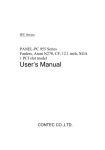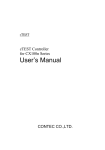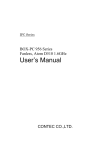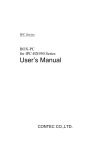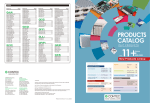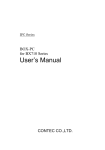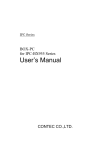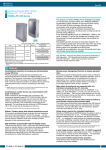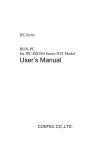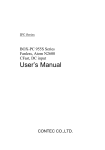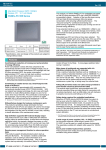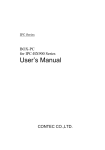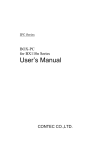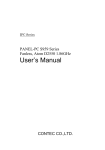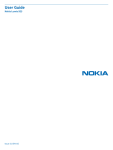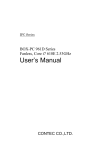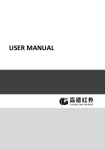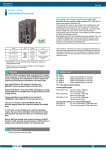Download User`s Manual
Transcript
IPC Series PANEL-PC 955 Series Fanless, Atom N270, CF, 12.1 inch XGA model User’s Manual CONTEC CO.,LTD. Check Your Package Thank you for purchasing the CONTEC product. The product consists of the items listed below. Check, with the following list, that your package is complete. If you discover damaged or missing items, contact your retailer. If you use IPC-SLIB-01 (driver & utility software set), download it from the CONTEC’s Web site. Product Configuration List PT-955LXC-DC5311 [Panel Mount] OS-installed model [WES2009] Japanese Name Panel-PC Waterproof packing The attachment fittings CF card removal prevention fitting Power supply connector complete set Power connector Contact Cable clamp DVI-analog RGB conversion adapter Product guide (this sheet) IPC Precaution List Warranty Certificate Serial number label Royalty consent contract Setup Procedure Document Notes on using Windows Embedded Standard Recovery Media *2 Pcs. 1 1 8 1 *1 1 4 1 1 1 1 1 1 1 1 1 1 *1 It is attached to the main body. *2 Please confirm latest information on the CONTEC homepage though the user's manual is stored in Recovery Media. PT-955LXC-DC5311 User’s manual i Product Configuration Image Power connector Contact Panel-PC (PT-955LXC-DC5311) The attach ment fittings (for PT955LXC) Product guide Waterproof packing (for PT955LXC) CF card removal prevention fitting IPC Precaution List Cable clamp Power supply connector complete set DVI-analog RGB conversion adapter Royalty consent contract Product guide IPC Precaution List Royalty consent contract Setup Procedure Document Notes on using Windows Embedded Standard Setup Procedure Document Notes on using Windows Embedded Standard Recovery Media Warranty Certificate XXXX XXXXXX XXX XXXX XXXXXX XXX Warranty Certificate Serial number label * See the Product Configuration List to check if all the components are included for the specified number of units. About the handling of the battery and the storage battery in E U signatory Note: This symbol mark is for EU countries only. This symbol mark is according to the directive 2006/66/EC Article 20 Information for end-users and Annex II. This symbol means that batteries and accumulators, at their end-of-life, should be disposed of separately from your household waste. If a chemical symbol is printed beneath the symbol shown above, this chemical symbol means that the battery or accumulator contains a heavy metal at a certain concentration. This will be indicated as follows: Hg: mercury (0.0005%), Cd: cadmium (0.002%), Pb: lead (0.004%) These ingredients may cause serious hazardous for human and the global environment. Please refer to the user's manual for the annulment of detaching a detailed battery specification and the battery and the batteries. ii PT-955LXC-DC5311 User’s manual Copyright Copyright 2013 CONTEC CO., LTD. ALL RIGHTS RESERVED. No part of this document may be copied or reproduced in any form by any means without prior written consent of CONTEC CO., LTD. CONTEC CO., LTD. makes no commitment to update or keep current the information contained in this document. The information in this document is subject to change without notice. All relevant issues have been considered in the preparation of this document. Should you notice an omission or any questionable item in this document, please feel free to notify CONTEC CO., LTD. Regardless of the foregoing statement, CONTEC assumes no responsibility for any errors that may appear in this document or for results obtained by the user as a result of using this product . Trademarks Intel, Intel Atom, Intel Core and Celeron are registered trademarks of Intel Corporation. MS, Microsoft and Windows are trademarks of Microsoft Corporation. Other brand and product names are trademarks of their respective holder. PT-955LXC-DC5311 User’s manual iii Table of Contents Check Your Package .................................................................................................................................... i Copyright .................................................................................................................................................... iii Trademarks ................................................................................................................................................. iii Table of Contents ....................................................................................................................................... iv 1. INTRODUCTION 1 About the Product ....................................................................................................................................... 1 Features ................................................................................................................................................. 1 Supported OS ....................................................................................................................................... 2 Customer Support........................................................................................................................................ 3 Web Site ............................................................................................................................................... 3 Limited One-Year Warranty ...................................................................................................................... 3 How to Obtain Service................................................................................................................................ 3 Liability ........................................................................................................................................................ 3 Safety Precautions ....................................................................................................................................... 4 Safety Information ............................................................................................................................... 4 Caution on the PT-955 Series ............................................................................................................. 4 2. SYSTEM REFERENCE 7 Specification ................................................................................................................................................ 7 Power Management Features ................................................................................................................... 11 Power Requirements ................................................................................................................................. 11 Power Consumption .......................................................................................................................... 11 Physical Dimensions ................................................................................................................................. 12 3. HARDWARE SETUP 13 Before Using the Product for the First Time .......................................................................................... 13 Hardware Setup ......................................................................................................................................... 14 Attaching the CF Attachment Fittings ............................................................................................. 14 Attaching the FG ................................................................................................................................ 14 Fastening the Cable ........................................................................................................................... 15 Hardware Setup .................................................................................................................................. 15 Installation Requirements ................................................................................................................. 18 4. EACH COMPONENT FUNCTION 21 Component Name ...................................................................................................................................... 21 Side view ............................................................................................................................................ 21 System Configuration ............................................................................................................................... 22 iv PT-955LXC-DC5311 User’s manual Component Function ................................................................................................................................. 23 LED: POWER, ACCESS, STATUS ................................................................................................ 23 DC Power Input Connector: DC-IN ................................................................................................. 23 Power switch: POWER SW .............................................................................................................. 24 Line out Interface: LINE OUT ......................................................................................................... 24 Mic in Interface: MIC ........................................................................................................................ 24 Giga bit-Ethernet: LAN A - B .......................................................................................................... 25 USB Ports: USB ................................................................................................................................. 26 Serial Port Interface: SERIAL A - B ................................................................................................ 27 DVI Interface: DVI ............................................................................................................................ 28 CF Card Connector (Primary IDE Connection): CF1 - 2 ............................................................... 30 5. BIOS SETUP 31 Introduction ................................................................................................................................................ 31 Starting Setup ............................................................................................................................................ 31 Using Setup ........................................................................................................................................ 32 Getting Help ....................................................................................................................................... 32 In Case of Problems ........................................................................................................................... 32 A Final Note About Setup ................................................................................................................. 32 Main Menu ................................................................................................................................................. 33 Setup Items ......................................................................................................................................... 33 Standard CMOS Setup .............................................................................................................................. 35 Main Menu Selections .............................................................................................................................. 36 IDE Adapters ...................................................................................................................................... 37 Advanced BIOS Features Setup ............................................................................................................... 38 CPU Feature ............................................................................................................................................... 39 Hard Disk Boot Priority ............................................................................................................................ 40 Virus Warning .................................................................................................................................... 41 Advanced Chipset Features Setup ........................................................................................................... 48 PCI Express Root Port Function .............................................................................................................. 51 VGA setting ............................................................................................................................................... 52 Integrated Peripherals ............................................................................................................................... 53 OnChip IDE Device .................................................................................................................................. 54 On Chip Serial ATA setting ..................................................................................................................... 58 Onboard Device ......................................................................................................................................... 59 Super IO Device ........................................................................................................................................ 63 Power Management Setup ........................................................................................................................ 65 PnP/PCI Configuration Setup................................................................................................................... 71 IRQ Resources ........................................................................................................................................... 73 PCI Express relative items........................................................................................................................ 76 PT-955LXC-DC5311 User’s manual v PC Health Status........................................................................................................................................ 77 Frequency/Voltage Control ...................................................................................................................... 79 Defaults Menu ........................................................................................................................................... 80 Supervisor/User Password Setting ........................................................................................................... 81 Exit Selecting............................................................................................................................................. 82 POST Messages ......................................................................................................................................... 82 POST Beep ................................................................................................................................................ 82 Error Messages .......................................................................................................................................... 83 6. APPENDIX 85 Memory Map ............................................................................................................................................. 85 I/O Port Addresses .................................................................................................................................... 86 Interrupt Level List ................................................................................................................................... 87 POST Codes............................................................................................................................................... 88 SERIAL I/O Address and Register Function .......................................................................................... 93 Watch-Dog-Timer ..................................................................................................................................... 99 Life of CF................................................................................................................................................. 103 Battery ...................................................................................................................................................... 104 7. vi LIST OF OPTIONS 107 PT-955LXC-DC5311 User’s manual 1. Introduction 1. Introduction About the Product This product is a fanless PANEL-PC for embedded use based on Intel (R) Atom processor N270 and a 945GSE (GMA950 incorporated) chipset. Adoption of the long life power saving LED and Intel (R) Atom processor offers low power consumption while ensuring sufficient performance. The “resource-saving PC” contributes downsizing and power-saving of equipment to reduce your running cost and to promote energy efficiency. It has extended interfaces such as 1000BASE-T, USB2.0, and serial. It adopts CF card for the storage and is fanless, which demonstrate the totally spindleless design that simplifies the maintenance. Embedded-type CPU and chip set have been adopted. The use of readily available parts ensures the ease of the use of the product. In addition, the use of CONTEC-customized BIOS allows support to be provided at the BIOS level. According to your application, two types (the panel mount type and the open frame type) are available. This product is available in the following 1 model: - WES-installed model and panel mount type equipped with Intel Atom Processor N270 1.60GHz PT-955LXC-DC5311 (12.1 inch, LCD (XGA), Memory 1GB, Windows Embedded Standard 2009 (Japanese version), CF 2GB) Features - Contributing to reduction of running cost and promotion of energy efficiency Power consumption is about 30% less compared to the conventional standard model (IPC-PT700HX-AC426). Due to adoption of the low power consumption LED backlight and Intel (R) Atom processor N270, low power consumption, approximately 41W*1 even at a high load condition, is achieved at the same time sufficient performance is ensured, contributing to the lesser running cost. *1 Median value of power consumption of a standard model PT-955LXC-DC5311 with input power of 24VDC under unloaded and fully-loaded conditions. - High definition supported DVI external display output This product has the up to 1920 x 1080 pixels DVI external display output as standard feature. A stand-alone two-displays application which, for example, displays the screen on a big LCD TV separately from the main LCD, can be built. Also, with the accompanying analog RGB (15 pin HD-SUB) conversion adapter, connecting to an analog RGB display is supported. - Remote power management function to reduce operation tasks This product supports timed/automated system start-up (Resume By Alarm). For example, it enables unattended operation, such as starting to show information of an establishment in unison at opening time. Also, it supports system start-up externally via network (Wake On LAN) and modem (Power On by Ring). It encourages significant labor saving in operation. - Major types of peripherals are supported with rich interfaces including the two CF card slots It has a variety of extended interface such as 1000BASE-T x 2, USB2.0 x 4, serial (RS-232C) x 2. It has 2 CF card slots that can use for OS and data. They are very useful because you can use one slot for system start-up and the other for maintenance, system log, or taking away the collected data. PT-955LXC-DC5311 User’s manual 1 1. Introduction - Falling-off prevention tools and cable clamps provided to avoid trouble caused by disconnected cable This product stays trouble-free, being equipped with USB removal prevention fitting and cable clamp for connectors with no locking mechanism, such as USB cable, and with hardware to properly mount and avoid falling out of CF card. - Safety design required for embedded applications Retention of CMOS data by EEPROM allows the system to start up even when the battery has run out. For Windows Embedded Standard installed model, it is possible to use the EWF*2 function of OS. It is designed for safety required for embedding purpose, for example, prohibiting unwanted writing to the CF card with EWF function will relieve the concern about the writing limits to the CF card and prevent an unintentional system alteration. *2 EWF (Enhanced Write Filter) is a function specific to Windows Embedded Standard that protects the disk from being actually written by redirecting the writing to RAM. - A wide range of power supplies (10.8 - 31.2VDC) supported As the product supports a wide range of power (10.8 - 31.2VDC), it can be used in a variety of power environments. The separately available AC adapter adds support for 100VAC power. *3 *3 When using the AC adapter, limits are placed on the expansion board power supply capacity and the external device power supply capacity. - Touch panel enables keyboard-less operation. These products have analog touch panel enabling mouse emulation using driver software. Supported OS - 2 Windows Embedded Standard 2009 (PT-955LXC-DC5311) PT-955LXC-DC5311 User’s manual 1. Introduction Customer Support CONTEC provides the following support services for you to use CONTEC products more efficiently and comfortably. Web Site Japanese English Chinese http://www.contec.co.jp/ http://www.contec.com/ http://www.contec.com.cn/ Latest product information CONTEC provides up-to-date information on products. CONTEC also provides product manuals and various technical documents in the PDF. Free download You can download updated driver software and differential files as well as sample programs available in several languages. Note! For product information Contact your retailer if you have any technical question about a CONTEC product or need its price, delivery time, or estimate information. Limited One-Year Warranty CONTEC products are warranted by CONTEC CO., LTD. to be free from defects in material and workmanship for up to one year from the date of purchase by the original purchaser. Repair will be free of charge only when this device is returned freight prepaid with a copy of the original invoice and a Return Merchandise Authorization to the distributor or the CONTEC group office, from which it was purchased. This warranty is not applicable for scratches or normal wear, but only for the electronic circuitry and original products. The warranty is not applicable if the device has been tampered with or damaged through abuse, mistreatment, neglect, or unreasonable use, or if the original invoice is not included, in which case repairs will be considered beyond the warranty policy. How to Obtain Service For replacement or repair, return the device freight prepaid, with a copy of the original invoice. Please obtain a Return Merchandise Authorization number (RMA) from the CONTEC group office where you purchased before returning any product. * No product will be accepted by CONTEC group without the RMA number. Liability The obligation of the warrantor is solely to repair or replace the product. In no event will the warrantor be liable for any incidental or consequential damages due to such defect or consequences that arise from inexperienced usage, misuse, or malfunction of this device. PT-955LXC-DC5311 User’s manual 3 1. Introduction Safety Precautions Understand the following definitions and precautions to use the product safely. Safety Information This document provides safety information using the following symbols to prevent accidents resulting in injury or death and the destruction of equipment and resources. Understand the meanings of these labels to operate the equipment safely. DANGER DANGER indicates an imminently hazardous situation which, if not avoided, will result in death or serious injury. WARNING WARNING indicates a potentially hazardous situation which, if not avoided, could result in death or serious injury. CAUTION CAUTION indicates a potentially hazardous situation which, if not avoided, may result in minor or moderate injury or in property damage. Caution on the PT-955 Series Handling Precautions WARNING - Always check that the power supply is turned off before connecting or disconnecting power cables. - Procedures that could result in serious injury or loss of human life should never be performed from a touch panel. Use system design methods that can guard against input errors. - Do not modify the product. - Always turn off the power before inserting or removing circuit boards or cables. - This product is not intended for use in aerospace, space, nuclear power, medical equipment, or other applications that require a very high level of reliability. Do not use the product in such applications. - If using this product in applications where safety is critical such as in railways, automotive, or disaster prevention or security systems, please contact your retailer. - Do not attempt to replace the battery as inappropriate battery replacement poses a risk of explosion. - For battery replacement, contact your retailer as it must be performed as a process of repair. - When disposing of a used battery, follow the disposal procedures stipulated under the relevant laws and municipal ordinances. 4 PT-955LXC-DC5311 User’s manual 1. Introduction CAUTION - - - - - Do not use or store this product in a location exposed to high or low temperature that exceeds range of specification or susceptible to rapid temperature changes. Example: - Exposure to direct sun - In the vicinity of a heat source Do not use this product in extremely humid or dusty locations. It is extremely dangerous to use this product with its interior penetrated by water or any other fluid or conductive dust. If this product must be used in such an environment, install it on a dust-proof control panel, for example. Avoid using or storing this product in locations subject to shock or vibration that exceeds range of specification. Do not use this product in the vicinity of devices that generate strong magnetic force or noise. Such products will cause this product to malfunction. Do not use or store this product in the presence of chemicals. To clean this product, wipe it gently with a soft cloth dampened with either water or mild detergent. Do not use chemicals or a volatile solvent, such as benzene or thinner, to prevent pealing or discoloration of the paint. This product’s case may become hot. To avoid being burned, do not touch that section while this product is in operation or immediately after turning off the power. Avoid installation in a location where people may come into contact with that section. CONTEC does not provide any guarantee for the integrity of data on CF. Always disconnect the power cable from the receptacle before mounting or removing the expansion board, or before connecting or disconnecting any connector. To prevent corruption of files, always shutdown the OS before turning off this product. CONTEC reserves the right to refuse to service a product modified by the user. In the event of failure or abnormality (foul smells or excessive heat generation), unplug the power cord immediately and contact your retailer. To connect with peripherals, use a grounded, shielded cable. Do not use any sharp-pointed object such as a mechanical pencil to touch the touch panel. Doing so may scratch the touch panel, resulting in malfunctions. - Do not subject the touch panel to shock as doing so may break it. - When the surface or frame of the touch panel has become dirty, wipe it with neutral detergent. Do not wipe the touch panel with thinner, alcohol, ammonia, or a strong chlorinated solvent. Use a protective sheet (available as an option) if the touch panel is used where it can easily collect dust and dirt. - It is a characteristic of analog touch panels that their resistance may vary with changes to the ambient environment (temperature and humidity) and with their own aging, resulting in the deviation of the detection point. If this is the case, calibrate the touch panel again to re-set calibration data. - LCD may have a few bright spots that are always on or a few black spots that are always off. Color irregularity may also occur depending on the viewing angle. This however is due to the structural characteristics of the LCD; therefore, it is not a product fault. PT-955LXC-DC5311 User’s manual 5 1. Introduction - - - Burn-in on TFT Display “Burn-in” may occur if the same display is retained for a long time. Avoid this by periodically switching the display so that the same display is not maintained for a long time. * Burn-In : Phenomenon characterized by a TFT display as a result of long-time display of the same screen where a shadow-like trace persists because electric charge remains in the LCD element even after the patterns are changed. The CF card connector doesn't support hot plug. The pulling out opening of the CF card cannot be done in the state of power supply ON. Please neither pulling out opening of CF in the state of power supply ON of this product nor come in contact with CF. This product may malfunction or cause a failure. Component Life: (1) Battery---The internal calendar clock and CMOS RAM are backed by a Lithium primary battery. The backup time at a temperature of 25°C with the power disconnected is 10 years or more. (2) CF ---The OS-installed model uses a CF card in the OS storage area. Estimated failure rates: 100,000 rewrite cycles, 500,000 hours MTBF. For more details, refer to Section 6 “Life of CF”. (3) Touch panel--- The operating lifetime of the touch panel is at least 1 million touches (as tested by mechanical touching under 300g of force at a rate of two presses per second). (4) LCD backlight--- Display brightness decreases over time with use. The operating lifetime of the backlight is 50,000 hours (the time until the brightness is lowered to 50% of the initial value). * Replacement of expendables is handled as a repair (there will be a charge). * Component life is not guaranteed value but only referential value. FCC PART 15 Class A Notice NOTE This equipment has been tested and found to comply with the limits for a Class A digital device, pursuant to part 15 of the FCC Rules. These limits are designed to provide reasonable protection against harmful interference when the equipment is operated in commercial environment. This equipment generates, uses, and can radiate radio frequency energy and, if not installed and used in accordance with the instruction manual, may cause harmful interference to radio communications. Operation of this equipment in a residential area is likely to cause harmful interference at his own expense. WARNING TO USER Change or modifications not expressly approved the manufacturer can void the user's authority to operate this equipment. 6 PT-955LXC-DC5311 User’s manual 2. System Reference 2. System Reference Specification Table 2.1. Functional Specification < 1 / 2 > Model PT-955LXC-DC5311 Assembly type Panel mounted CPU Intel® Atom™ Processor N270 (1.60GHz / FSB533MHz) Chip set Intel® 945GSE + ICH7M-DH BIOS BIOS (mfd. by Award) Memory Graphic 1GB ( 200pin SO-DIMM x 1), PC2-4300 DDR2 SDRAM Controller Intel® GMA950 (Built in 945GSE chip set) Multi-monitor function supported *1 LCD type Touch panel External display output Video RAM Main memory shared Video BIOS 64KB(C0000H-CFFFFH) LCD type 12.1-inch TFT color LCD, XGA(1024 x 768), 260,000 colors Backlight LED method, The ON/OFF software can control. Resolution 4096 x 4096 (emulated in 1024 x 768 mode) Detection method Resistive-film analog type Connection Internal serial port DVI*2 640 x 480, 800 x 600, 1,024 x 768, 1,152 x 864, 1,280 x 600, 1,280 x 720, 1,280 x 768, 1,280 x 960, 1,280 x 1,024, 1,360 x 768, 1,400 x 1,050, 1,600 x 900, 1,600 x 1,200, 1,856 x 1,392, 1,920 x 1,080, 1,920 x 1,200 (16,770,000 colors) Analog RGB 640 x 480, 800 x 600, 1,024 x 768, 1,280 x 768, 1,280 x 1,024, 1,360 x 768, 1,400 x 1,050 (16,770,000 colors) Audio AC97 compliant, LINE OUT x 1, MIC IN x 1 IDE Primary IDE Master / Slave (Max 2 devices), CF card slot connection LAN*3 Intel® 82573L Controller 1000BASE-T/100BASE-TX/10BASE-T x 2 (Wake On LAN support) USB USB 2.0-compliant 4 port Serial RS-232C 3 port (one of the ports is used for touch panel), Baud rate: 50 - 115,200bps General-purpose I/O None Hardware monitoring Monitoring CPU temperature, board temperature, power voltage Watch dog timer Software programmable, 255 level (1sec - 255 sec), Causes a reset upon time-out. Real-time clock ICH7M-DH integrated, The real-time clock is accurate within 3 minutes (at 25C) per month, Lithium backup battery life : 10 years or more Power Management Power management setup via BIOS, Power On by Ring / Wake On LAN, Supports PC98/PC99 ACPI Power management *1: A multi-screen display function using the main LCD and an external display. The “Twin” option is, however, not available for a combination with an external DVI-connected display. “Extended desktop” or “Intel ® dual display clone” can be used instead. *2: Display of the DVI-connected screen becomes active after the Windows starts up. *3: Care about ambient temperature when using 1000BASE-T. Refer to “Installation Requirements” in chapter 3 for details. PT-955LXC-DC5311 User’s manual 7 2. System Reference Table 2.1. Functional Specification < 2 / 2 > Model Interface PT-955LXC-DC5311 External display 1 port (29 pin DVI-I connector ), DVI-analog RGB conversion adapter attachment Audio LINE OUT: 3.5 Stereo mini jack, Full-scale output level 1.5Vrms (Typ.), Dual 50mW Amplifier MIC IN: 3.5 Stereo mini jack, Full-scale input level 1.3Vrms (Typ.) CF card slot 2 slots (CF1/CF2), CF CARD Type I, bootable CF1 is finished mounting CF (2GB, 1 partition) *4 Power supply LAN*3 2 port (RJ-45 connector) USB 4 port (A-TYPE connector) RS-232C 2 port (9pin D-SUB connector [male]) Power supply connector 12 - 24VDC *5 Input power 10.8 - 31.2VDC supply voltage Current consumption 12VDC: 3.5A(Typ.) 4.5A (Max.) 24VDC: 1.7A(Typ.) 2.3A (Max.) External device power supply capacity +12VDC 0.5A +5VDC 1A *7 +3.3VDC 0.5A *7 -12V 80mA CF Card slot : +3.3VDC 1A (500mA per one slot), USB port : +5VDC 2A (500mA per one slot) *6 Waterproofing and dust-proofing Front panel IP65 standard Panel cut dimensions (mm) 303.0 (W) x 243.0 (H) Physical dimensions (mm) 316 (W) x 102.8 (D) x 256 (H) (internal-panel depth) (Storage device isn't included) Weight 4.0kg (without mounting bracket) 4.1kg (with mounting bracket) *4: The capacity of CF is a value when 1GB is calculated by 1 billion bytes. The capacity that can be recognized from OS might be displayed fewer than an actual value. *5: Use a power cable shorter than 3m. *6: Ensure that the total current for the USB port power supply capacity is 2.5 A or lower. When using a total current 1.5 A or higher, be careful of the ambient temperature. For details, refer to chapter3, Installation Requirements. 8 PT-955LXC-DC5311 User’s manual 2. System Reference Table 2.2. Installation Environment Requirements Model PT-955LXC-DC5311 < When using 100BASE-TX/10BASE-T > Operating temperature *7 0 - 50C (When the total current for the USB port power supply capacity is 1.5 A or higher : 0 - 45°C) < When using 1000BASE-T > 0 - 45C (When the total current for the USB port power supply capacity is 1.5 A or higher : 0 - 40°C) Storage temperature -10 - 60C Operating humidity 10 - 90%RH (No condensation) Floating dust particles Not to be excessive Corrosive gas None Noise resistance Vibration resistance Line noise AC line / 2kV *8, Signal line/1kV (IEC61000-4-4 Level 3, EN61000-4-4 Level 3) Static electricity resistance Contact discharge / 4kV (IEC61000-4-2 Level 2, EN61000-4-2 Level 2), Atmospheric discharge / 8kV (IEC61000-4-2 Level 3, EN61000-4-2 Level 3) Sweep resistance 10 - 57Hz / semi-amplitude 0.15 mm 57 - 150Hz / 2.0G, 40 min. each in x, y, and z directions (JIS C60068-2-6-compliant, IEC60068-2-6-compliant) Impact resistance 10G, half-sine shock for 11 ms in x, y, and z directions (JIS C60068-2-27-compliant, IEC60068-2-27-compliant) Grounding Class D grounding, SG-FG / continuity *7: For more details on this, please refer to chapter 3, “Installation Requirements”. *8: When using the AC-DC power supply. PT-955LXC-DC5311 User’s manual 9 2. System Reference Display Optical Specifications Table 2.3. Display Optical Specifications Parameter Condition = 180° Visual angle (vertical) = 0° CR10 Visual angle = +90° (horizontal) Display. Monochrome = -90° Surface brightness (at center) Display in white Min. Typ. 70deg 80deg 70deg 80deg 70deg 80deg 70deg 80deg 190cd/m2 250cd/m2 * “Surface brightness” represents a numerical value per display. The expected brightness through a touch panel is about 80% lower than the above value. Contrast ratio (CR) = Brightness at screen center with white displayed Brightness at screen center with black displayed Measurement direction Z ( = 0o ) Left ( = -90o ) Top ( = 180o ) X Module Bottom ( = 0o ) Right ( = 90o ) Y Figure 2.1. Definition of viewable range CAUTION The above optical specification data shows optical characteristics of the liquid crystal in the display; the data does not represent the actual view on the display or its viewing angles. 10 PT-955LXC-DC5311 User’s manual 2. System Reference Power Management Features - Support both ACPI (Advanced Configuration and Power Interface) and legacy (APM) power management. - ACPI v2.0 compliant - APM v1.2 compliant - Support hardware automatic wake-up Power Requirements Your system requires a clean, steady power source for reliable performance of the high frequency CPU on the product, the quality of the power supply is even more important. For the best performance makes sure your power supply provides a range of 10.8 V minimum to 31.2 V maximum DC power source. Power Consumption For typical configurations, the CPU card is designed to operate with at least a 60W power supply. The power supply must meet the following requirements : - Rise time for power supply: 2 ms - 30 ms The following table lists the power supply’s tolerances for DC voltages: Table 2.4. DC voltage tolerance DC Voltage Acceptable Tolerance + 12 - 24VDC + 10.8 - 31.2VDC PT-955LXC-DC5311 User’s manual 11 2. System Reference Physical Dimensions PT-955LXC-DC5311 Front 330 5.4 346 287 271 43.8 [mm] Back face 242 100 69.5 302 100 4-M4 *1 1 12 - 24 VDC 2 A B CF A B STATUS [mm] *1: The length (L) from the tip of M4 boss to the M4 screw tip should be 5mm or less. If not doing so, it may be exactly fixed. 5 MAX VESA PLATE M4 SCREW M4BOSS Figure 2.2. Physical Dimensions (PT-955LXC-DC5311) 12 PT-955LXC-DC5311 User’s manual 3. Hardware Setup 3. Hardware Setup Before Using the Product for the First Time Follow the next steps to set up this product: STEP1 By referring to the information in this chapter, install, connect and set this product. STEP2 Connect cables. Connect the cable of necessary external devices, such as keyboard and a mouse, to this product using appropriate cables. STEP3 Turn on the power. After verifying that you have correctly followed steps 1 and 2, turn on the power. If you find any abnormality after turning on the power, turn it off and check to see if the setup has been performed properly. STEP4 Set up BIOS. By referring to Chapter 5, set up BIOS. This setup requires a keyboard. * Before using this product, be sure to execute “LOAD SETUP DEFAULTS” to initialize the BIOS settings to their default values. (See Chapter 5, “Main Menu.”) CAUTION Be sure to connect the keyboard and mouse to it before turning the power on for the first time. PT-955LXC-DC5311 User’s manual 13 3. Hardware Setup Hardware Setup - Before you start, be sure that the power is turned off. Remove only those screws that are explained. Do not move any other screw. Attaching the CF Attachment Fittings (1) After inserting a CF Card, fasten the bundled CF attachment fittings with a screw. Figure 3.1. Attaching the CF Attachment Fittings CAUTION - Insert the CF Card face up. - Screw holes may be damaged if screws are tightened with a torque greater than the specified torque. The specified tightening torque is 3 - 3.5kgfcm. Attaching the FG (1) Use screws to attach the FG. * Attached screw (M3 x 8) Figure 3.2. Attaching the FG CAUTION The FG pin of this product is connected to the GND signal of the DC power connector (DC-IN). Note that the connection cannot be cut off. Screw holes may be damaged if screws are tightened with a torque greater than the specified torque. The specified tightening torque is 5 - 6kgfcm. 14 PT-955LXC-DC5311 User’s manual 3. Hardware Setup Fastening the Cable This product comes with clamps for fixing cables. Fastening the LINEOUT, USB Cable The system unit has a hole for attaching cable clamp. Using a cable clamp for a cable with lock-less connector, such as the LINEOUT and USB Cable, prevents the connector from being unplugged. Use the cable ties and cable clamps appropriately according to the connecting states and wiring directions of cables. Figure 3.3. Attaching the cable clamp Hardware Setup PT-955LXC-DC5311 (1) Cut out a panel according to the following dimensions to mount the main unit. 272 +0.5 -0 331 +0.5 -0 4 rl 3o -R s es Panel thickness 1.6 - 7mm Figure 3.4. Dimensions of Panel Opening (PT-955LXC-DC5311) PT-955LXC-DC5311 User’s manual 15 3. Hardware Setup (2) Place the waterproof packing in the groove on the front face of the main body and insert the main body into the panel from the external side. Waterproof packing (supplied) Figure 3.5. Attaching the waterproof packing (PT-955LXC-DC5311) (3) Hold the attachment fittings from the inside of the panel. Installation panel The attachment fittings Panel-PC Overtightning screws may result in damage. Proper tightening torque for splash-proof is 0.25 - 0.3N m. Figure 3.6. Hardware Setup (PT-955LXC-DC5311) 16 PT-955LXC-DC5311 User’s manual 3. Hardware Setup When using VESA standard 100mm mounting holes The main body has mounting holes according to VESA standard 100mm. When using a VESA standard 100mm stand or the like, attach it as shown the following figure. VESA standards 100mm installation M4 Screws *1 *1: The length (L) from the tip of M4 boss to the M4 screw tip should be 5mm or less. If not doing so, it may be exactly fixed. 5 MAX VESA PLATE M4 SCREW Figure 3.7. M4BOSS Installation of VESA metal fittings PT-955LXC-DC5311 User’s manual 17 3. Hardware Setup Installation Requirements Be sure that the ambient temperature is within the range specified in the installation environment requirement by making space between the product and device that generates heat or exhaust air. Installed angle which is recommended 45 Installed angle of this product which is recommended is 0 - 45. Except for that, the temperature specification of this product might not be filled. 0° - + 45° Side view Figure 3.8. Installed angle which is recommended CAUTION Attention: Even if the ambient temperature is within the usage range, if the product is installed near devices that generate high temperatures, the product may experience the effects of radiation which will cause its temperature to rise and may lead to product malfunctions. 18 PT-955LXC-DC5311 User’s manual 3. Hardware Setup Distances between this product and its vicinity 50mm or more 50mm or more 50mm or more 50mm or more 50mm or more Installation panel Figure 3.9. Distances between this product and its vicinity CAUTION Do not install this product into the fully-sealed space except the case in which the internal temperature is adjustable by equipment such as air conditioner. Troubles such as operational malfunctions could be occurred by the temperature increase caused by long-term usage. Ambient temperature In this product, the ambient temperature is decided from the multiple measurement points as shown below. When making use of the product, the air current should be adjusted to prevent that all the temperatures measured at the measurement points exceed the specified temperature. 50mm 50mm 50mm Installation panel Figure 3.10. Measurement points of ambient temperature PT-955LXC-DC5311 User’s manual 19 3. Hardware Setup 20 PT-955LXC-DC5311 User’s manual 4. Each Component Function 4. Each Component Function Component Name Side view PT-955LXC-DC5311 POWER LED LINE-OUT CF1 1 SERIAL SERIAL A B CF2 2 A B CF A 12 - 24 VDC B STATUS LAN LAN DC-IN MIC-IN A B POWER SW USB DVI-I ACCESS STATUS LED LED Figure 4.1. Component Name Table 4.1. Component Function Name Function POWER-SW Power switch POWER LED Power ON display LED ACCESS LED IDE disk access display LED STATUS LED Status LED DC-IN DC power input connector LINE OUT Line out (3.5 PHONE JACK) MIC IN Mic in (3.5 PHONE JACK) LANA Ethernet 1000BASE-T/100BASE-TX/10BASE-T RJ-45 connector LANB Ethernet 1000BASE-T/100BASE-TX/10BASE-T RJ-45 connector USB USB port connector x 4 SERIALA Serial port A connector (9pin D-SUB/male) SERIALB Serial port B connector (9pin D-SUB/male) DVI-I Display (29pin female) CF1 CF card slot (IDE connection mastering) CF2 CF card slot (IDE connection slaving) PT-955LXC-DC5311 User’s manual 21 4. Each Component Function System Configuration PT-955LXC-DC5311 SERIAL port (A, B) LAN port (A, B) Display MIC IN LINE-OUT CF card USB2.0 USB device such as CD drive, printer, etc. Figure 4.2. System Configuration 22 PT-955LXC-DC5311 User’s manual 4. Each Component Function Component Function LED: POWER, ACCESS, STATUS There are 3 LED in front of this product. Table 4.2. Display Contents of LED LED name State POWER LED Display contents OFF Indicates that this product is switched off. ON (Green) Indicates that this product is switched on. ACCESS LED ON (Orange) Indicates that the IDE device is being accessed. STATUS LED OFF You can control the behavior of LED from the user application. *1 Flashing, ON (Red) You can control the behavior of LED from the user application. *1 *1 API that controls STATUS LED is available. See the API description file “mtdll_e.chm” included in /RasUtility/Samples in the CONTEC’s Web site [IPC-SLIB-01] for details. DC Power Input Connector: DC-IN To supply the power, always use the power supply listed below. Rated input voltage : 12 - 24VDC Range of input voltage : 10.8 - 31.2VDC Power capacity : 12V 4.5A or more, 24V 2.3A or more Table 4.3. DC Power Connector Connector type 9360-04P(mfd. by ALEX) Pin No. 4 3 2 1 Signal name 1 GND 2 GND 3 12 - 24V 4 12 - 24V Applicable connector on the connector side Housing Contact : 9357-04(mfd. by ALEX) or 5557-04R (mfd. by MOLEX) : 4256T2-LF(AWG18-24) (mfd. by ALEX) or 5556 (AWG18-24) (mfd. by MOLEX) Applicable connector on the connector side Voltage 2 - 30mS 12V Time Figure 4.3. Graph of Rise Time of Power Supply PT-955LXC-DC5311 User’s manual 23 4. Each Component Function Power switch: POWER SW POWER SW is provided. Line out Interface: LINE OUT A line output connector is provided. You can plug a headphone or amplifier-integrated speakers into this connector. Mic in Interface: MIC A MIC input connector is provided. You can plug a microphone to this connector for sound input. Audio driver The audio driver is required to use the microphone input and line output interfaces. Install the appropriate audio driver for your OS from the CONTEC’s Web site CD-ROM [IPC-SLIB-01]. (For information on the latest version of IPC-SLIB-01, check the CONTEC's Web site.) 24 PT-955LXC-DC5311 User’s manual 4. Each Component Function Giga bit-Ethernet: LAN A - B This product is equipped with 2 ports for giga bit. - Network type : 1000BASE-T/100BASE-TX/10BASE-T - Transmission speed * : 1000M/100M/10M bps - Max. network path length : 100m/segment - Controller : Intel 82573L Table 4.4. Giga bit-Ethernet Connector Function Pin No. LAN Transmit LED 8 Link LED 1 100BASE-TX 1000BASE-T 1 TX+ TRD+(0) 2 TX- TRD-(0) 3 RX+ TRD+(1) 4 N.C. TRD+(2) 5 N.C. TRD-(2) 6 RX- TRD-(1) 7 N.C. TRD+(3) 8 N.C. TRD-(3) LEDs for display of network statuses: Right LED Normal connection Left LED 10M: Off, 100M : : : : Link LED Green ON, Operation: Green Blinking Operation LED Green, 1000M: Orange LAN drivers Install the appropriate LAN driver for your OS from the CONTEC’s Web site [IPC-SLIB-01]. (For information on the latest version of IPC-SLIB-01, check the CONTEC's web site.) CAUTION - Attention should to be paid to the guaranteed operating range of temperature in using 1000BASE-T. For more details on this, refer to chapter3, Installation Requirements. Note that the Ethernet should be configured as 100BASE-TX or 10BASE-T in using under the temperature 0 - 50°C. - If you want to use WOL function, please select "Enable" at the item "Enable PME" of OS driver setting. PT-955LXC-DC5311 User’s manual 25 4. Each Component Function USB Ports: USB This product is equipped with 4 port for USB 2.0 interface. Table 4.5. USB Connector 26 Pin No. Function 1 USB_VCC 2 USB- 3 USB+ 4 USB_GND PT-955LXC-DC5311 User’s manual 4. Each Component Function Serial Port Interface: SERIAL A - B SERIAL A, B (RS-232C Ports) The product has 2 ports of RS-232C compliant serial ports supporting up to a baud rate of 115,200bps with a 16-byte transmission-dedicated data buffer and a 16-byte reception-dedicated data buffer. You can use “Chapter 5 BIOS Setup” to configure an I/O address, interrupt and unused state for each of the ports independently. (The same I/O address and IRQ cannot be shared with any other device.) Please refer to “Chapter 6 I/O Port Addresses” for more information on I/O address and register function. Table 4.6. SERIAL A, B, C, D, E I/O Addresses and Interrupts SERIAL I/O address Interrupt A 3F8h - 3FFh IRQ 4 B 2F8h - 2FFh IRQ 3 2A0h-2A7h IRQ5 C (touch panel) D (system reserved) E (system reserved) Table 4.7. Serial Port Connector Connector used on 9-pin D-SUB (MALE) the product 1 5 6 Pin No. Signal name No.4-40UNC Inch screw threads 9 Meaning Direction 1 CD Carrier detect 2 RD Received data Input 3 TD Transmitted data Output Output Input 4 DTR Data terminal ready 5 GND Signal ground ----- 6 DSR Data set ready Input 7 RTS Request to send Output 8 CTS Clear to send Input 9 RI Ring indicator Input PT-955LXC-DC5311 User’s manual 27 4. Each Component Function DVI Interface: DVI A DVI interface is provided. You can use it to connect a CRT (even a D-SUB 15 pin connector is acceptable by using the bundled DVI-analog RGB adapter) or a CONTEC flat panel display. The connector is named DVI (DVI-I 29-pin connector). CAUTION Precautions when Using Additional Display - An additional display can be used to enable simultaneous screen display with the PANEL-PC main display. - If the resolution of the additional display is different from that of the PANEL-PC main display, the size of screen images on the additional display will be decreased or increased with lower image quality. - When using the main unit and touch panel function at the same time, use a USB connection for the touch panel. Table 4.8. DVI Connector Connector type 1 DVI-I 29 pin 8 C1 C2 C5 17 9 Pin No. Signal name 16 C3 Pin No. C4 Signal name Pin No. Signal name 1 DATA2- 13 N.C. C1 RED 2 DATA2+ 14 +5V C2 GREEN 15 GND C3 BLUE 3 DATA2 SHIELD 4 N.C. 16 HPD C4 HSYNC 5 N.C. 17 DATA0- C5 GND 6 DDC CLK 18 DATA0+ 7 DDC DATA 19 8 VSYNC 20 9 DATA1- 21 10 11 12 28 24 DATA1+ DATA1 SHIELD N.C. 22 DATA0 SHIELD N.C. N.C. DATA0 SHIELD 23 CLK+ 24 CLK- PT-955LXC-DC5311 User’s manual 4. Each Component Function Table 4.9. DVI-analog RGB conversion adapter Connector type C5 C4 C3 DVI-I 29 pin C2 C1 6 17 39.40 8 24 33.00 16 1 11 5 15 1 10 15.00 6.20 30.00 5.80 [mm] Signal on analog RGB Pin No. Signal name Pin No. 1 RED 9 Signal name +5V 2 GREEN 10 GND 3 BLUE 11 N.C. 4 N.C. 12 DDC DATA 5 GND 13 HSYNC 6 GND 14 VSYNC 7 GND 15 DDC CLK 8 GND For the LCDs that can be connected, please refer to “Chapter 7 List of Options”. Display driver Install the appropriate display driver for your OS from the CONTEC’s Web site [IPC-SLIB-01]. (For information on the latest version of IPC-SLIB-01, check the CONTEC's Web site.) CAUTION - You need to set the screen resolution if the display cable is not connected to this DVI-D interface at OS startup, but connected after OS startup (hereinafter referred to as “Late Insertion”). When the analog display is used, Windows MS-DOS may not be properly displayed in full-screen mode. This is because the frequency and resolution of Windows and MS-DOS (full-screen display) are the same due to the screen settings while the display parameters are different. For display, as only one parameter can be stored for one frequency or resolution, only either of Windows or MS-DOS screen can be displayed properly. In this case, change the resolution or display frequency of Windows so that it is not the same as for the MS-DOS display. PT-955LXC-DC5311 User’s manual 29 4. Each Component Function CF Card Connector (Primary IDE Connection): CF1 - 2 The CF Card (Type I : dedicated to the memory card) can be connected. The CF card connector doesn't support hot plug. The pulling out opening of the CF card cannot be done in the state of power supply ON. Please neither pulling out opening of CF in the state of power supply ON of this product nor come in contact with CF. This product may malfunction or cause a failure. Before you insert/remove the CF card, make sure that the power is switched off and the access LED is turned off. Table 4.10. CF Card Connector Connector 50-socket header type (1.27mm pitch) used on the product Pin No. Signal name 1 GND 2 DD3 3 DD4 4 30 1 25 26 50 Direction Pin No. Signal name 26 GND Direction I/O 27 DD11 I/O I/O 28 DD12 I/O DD5 I/O 29 DD13 I/O 5 DD6 I/O 30 DD14 I/O 6 DD7 I/O 31 DD15 I/O 7 CS0- Output 32 CD3- Output 8 GND 33 GND 9 GND 34 DIOR- Output 10 GND 35 DIOW- Output 11 GND 36 +3.3V 12 GND 37 INTRQ 13 +3.3V 38 +3.3V 14 GND 39 CSEL- 15 GND 40 N.C 16 GND 41 RESET- Output 17 GND 42 IOCHRDY Input 18 DA2 Output 43 DDRQ Input 19 DA1 Output 44 DDACK- Output 20 DA0 Output 45 DACT- Output 21 DD0 I/O 46 PDIAG- Output 22 DD1 I/O 47 DD8 I/O 23 DD2 I/O 48 DD9 I/O 24 N.C 49 DD10 I/O 25 GND 50 GND Input Output PT-955LXC-DC5311 User’s manual 5. BIOS Setup 5. BIOS Setup Introduction This chapter discusses Award’s Setup program built into the FLASH ROM BIOS. The Setup program allows users to modify the basic system configuration. This special information is then stored in battery-backed RAM so that it retains the Setup information when the power is turned off. The rest of this chapter is intended to guide you through the process of configuring your system using Setup. Starting Setup The Award BIOS is immediately activated when you first power on the computer. The BIOS reads the system information contained in the CMOS and begins the process of checking out the system and configuring it. When it finishes, the BIOS will seek an operating system on one of the disks and then launch and turn control over to the operating system. While the BIOS is in control, the Setup program can be activated in one of two ways: 1 By pressing <Del> immediately after switching the system on, or 2 By pressing the <Del> key when the following message appears briefly at the bottom of the screen during the POST (Power On Self-Test). Press DEL to enter SETUP. If the message disappears before you respond and you still wish to enter Setup, restart the system to try again by turning it OFF then ON. If USB Keyboard Support is set to “Enabled”, restart can be initiated by pressing the <Ctrl>, <Alt>, and <Delete> keys simultaneously. If you do not press the keys at the correct time and the system does not boot, an error message will be displayed and you will again be asked to. Press F1 to continue, DEL to enter SETUP PT-955LXC-DC5311 User’s manual 31 5. BIOS Setup Using Setup In general, you use the arrow keys to highlight items, press <Enter> to select, use the Page Up and Page Down keys to change entries, press <F1> for help and press <Esc> to quit. The following table provides more detail about how to navigate in the Setup program using the keyboard. Table 5.1. Using Setup Key Function Up Arrow Move to the previous item Down Arrow Move to the next item Left Arrow Move to the item on the left (menu bar) Right Arrow Move to the item on the right (menu bar) Esc Main Menu: Quit without saving changes Submenus: Exit Current page to the next higher level menu Move Enter Move to the item you desired PgUp key Increase the numeric value or make changes PgDn key Decrease the numeric value or make changes + key Increase the numeric value or make changes - key Decrease the numeric value or make changes Main Menu -- Quit and not save changes into CMOS Esc key Status Page Setup Menu and Option Page Setup Menu -- Exit current page and return to Main Menu F1 key General help on Setup navigation keys F5 key Load previous values from CMOS F6 key Load the fail-safe defaults from BIOS default table F7 key Load the optimized defaults F10 key Save all the CMOS changes and exit Getting Help Press F1 to pop up a small help window that describes the appropriate keys to use and the possible selections for the highlighted item. To exit the Help Window press <Esc> or the F1 key again. In Case of Problems If, after making and saving system changes with Setup, you discover that your computer no longer is able to boot, the AwardBIOS™ supports an override to the CMOS settings which resets your system to its defaults. The best advice is to only alter settings which you thoroughly understand. To this end, we strongly recommend that you avoid making any changes to the chipset defaults. These defaults have been carefully chosen by both Award and your systems manufacturer to provide the absolute maximum performance and reliability. Even a seemingly small change to the chipset setup has the potential for causing you to use the override. A Final Note About Setup The information in this chapter is subject to change without notice. 32 PT-955LXC-DC5311 User’s manual 5. BIOS Setup Main Menu Once you enter the Award BIOS CMOS Setup Utility, the Main Menu will appear on the screen. The Main Menu allows you to select from several setup functions and two exit choices. Use the arrow keys to select among the items and press <Enter> to accept and enter the sub-menu. Note that a brief description of each highlighted selection appears at the bottom of the screen. Figure 5.1. Main Manu Setup Items The main menu includes the following main setup categories. Recall that some systems may not include all entries. Standard CMOS Features Use this menu for basic system configuration. Advanced BIOS Features Use this menu to set the Advanced Features available on your system. Advanced Chipset Features Use this menu to change the values in the chipset registers and optimize your system's performance. Integrated Peripherals Use this menu to specify your settings for integrated peripherals. Power Management Setup Use this menu to specify your settings for power management. PnP / PCI Configuration This entry appears if your system supports PnP / PCI. PT-955LXC-DC5311 User’s manual 33 5. BIOS Setup Load Fail-Safe Defaults Use this menu to load the BIOS default values for the minimal/stable performance for your system to operate. Load Optimized Defaults Use this menu to load the BIOS default values that are factory settings for optimal performance system operations. While Award has designed the custom BIOS to maximize performance, the factory has the right to change these defaults to meet their needs. Supervisor / User Password Use this menu to set User and Supervisor Passwords. Save & Exit Setup Save CMOS value changes to CMOS and exit setup. Exit Without Save Abandon all CMOS value changes and exit setup. 34 PT-955LXC-DC5311 User’s manual 5. BIOS Setup Standard CMOS Setup Figure 5.2. Standard CMOS Setup The items in Standard CMOS Setup Menu are divided into 10 categories. Each category includes no, one or more than one setup items. Use the arrow keys to highlight the item and then use the <PgUp> or <PgDn> keys to select the value you want in each item. PT-955LXC-DC5311 User’s manual 35 5. BIOS Setup Main Menu Selections This table shows the selections that you can make on the Main Menu. Table 5.2. Main Menu Selections Item Options Description Set the system date. Note that the ‘Day’ Date Month DD YYYY automatically changes when you set the date Time HH : MM : SS Set the system time IDE Channel 0 Master Options are in its sub menu Press <Enter> to enter the sub menu of detailed options IDE Channel 0 Slave Options are in its sub menu Press <Enter> to enter the sub menu of detailed options IDE Channel 1 Master Options are in its sub menu Press <Enter> to enter the sub menu of detailed options IDE Channel 1 Slave Options are in its sub menu Press <Enter> to enter the sub menu of detailed options EGA/VGA Video CGA 40 CGA 80 Select the default video device Usually select EGA/VGA. MONO All Errors Select the situation in which you want the Halt On No Errors All, but Keyboard BIOS to stop the POST process and notify you Base Memory N/A Displays the amount of conventional memory detected during boot up Extended Memory N/A Total Memory N/A 36 Displays the amount of extended memory detected during boot up Displays the total memory available in the system PT-955LXC-DC5311 User’s manual 5. BIOS Setup IDE Adapters The IDE adapters control the CF card. Use a separate sub menu to configure each CF card. Use the legend keys to navigate through this menu and exit to the main menu. Use Table 5.3 to configure the hard disk. Table 5.3. IDE Adapters configurations Item IDE HDD Auto-detection Options Press Enter Description Press Enter to auto-detect the CF card on this channel. If detection is successful, it fills the remaining fields on this menu. IDE Channel 0/1 Master/Slave None Auto Manual Selecting ‘manual’ lets you set the remaining fields on this screen. Selects the type of fixed disk. “User Type” will let you select the number of cylinders, heads, etc. Note: PRECOMP=65535 means NONE ! CHS Access Mode LBA Large Choose the access mode for this CF card. Auto Capacity Auto Display your CF card size Disk drive capacity (Approximated). Note that this size is usually slightly greater than the size of a formatted disk given by a disk checking program. The following options are selectable only if the ‘IDE Channel 0/2 Master/Slave’ item is set to ‘Manual’ and ‘CHS’ item is set to ‘Manual’ Cylinder Head Min = 0 Max = 65535 Min = 0 Max = 255 Set the number of cylinders for this CF card. Set the number of heads for this CF card. Precomp Min = 0 Max = 65535 **** Warning: Setting a value of 65535 means no CF card Landing zone Min = 0 Max = 65535 **** Sector Min = 0 Max = 255 Number of sectors per track PT-955LXC-DC5311 User’s manual 37 5. BIOS Setup Advanced BIOS Features Setup This section allows you to configure your system for basic operation. You have the opportunity to select the system’s default speed, boot-up sequence, keyboard operation, shadowing and security. Figure 5.3. Advanced BIOS Features Setup 38 PT-955LXC-DC5311 User’s manual 5. BIOS Setup CPU Feature Figure 5.4. CPU Feature Press <Enter> to configure the settings relevant to CPU Feature. Table 5.4. CPU Features Selections Description Choice Delay Prior to Thermal Select the interval to setup the delay timer for CPU Thermal-Throttling. C1E Function CPU C1E Function Select. PT-955LXC-DC5311 User’s manual 39 5. BIOS Setup Description Choice Execute Disable Bit When disabled, forces the XD feature flag to always return 0. Hard Disk Boot Priority Figure 5.5. Hard Disk Boot Priority With the field, there is the option to choose, aside from the hard disks connected, “Bootable add-in Cards” which refers to other external device. 40 PT-955LXC-DC5311 User’s manual 5. BIOS Setup Virus Warning When enabled, you receive a warning message if a program (specifically, a virus) attempts to write to the boot sector or the partition table of the hard disk drive. You should then run an anti-virus program. Keep in mind that this feature protects only the boot sector, not the entire hard drive. CAUTION Many disk diagnostic programs that access the boot sector table can trigger the virus warning message. If you plan to run such a program, we recommend that you first disable the virus warning. Enabled Activates automatically when the system boots up causing a warning message to appear when anything attempts to access the boot sector or hard disk partition table. Disabled No warning message will appear when anything attempts to access the boot sector or hard disk partition table. Table 5.5. Advance BIOS Feature Selections Description Choice CPU L1 & L2 Cache These allow you to enable (speed up memory access) or disable the cache function. Hyper-Threading Technology These allow you to enable or disable the Hyper-Threading function. PT-955LXC-DC5311 User’s manual 41 5. BIOS Setup Description Choice Quiet Post Skip certain self-diagnosis processes such as checking memory or other several devices for shorter bootup time. Default setting (Disabled) does not simplify the self-diagnosis process. Quick Power On Self Test Select Enabled to reduce the amount of time required to run the power-on self-test (POST). A quick POST skips certain steps. We recommend that you normally disable quick POST. Better to find a problem during POST than lose data during your work. USB Device Wait When USB devices, which need longer time to be booted, are connected, the boot possibly can not be processed in normal condition. To address such cases, this setting specifies the waiting time for BIOS and delays the start of the access to the USB devices. Therefore, the boot will be delayed by the specified waiting time. First Boot Device The BIOS attempts to load the operating system from the devices in the sequence selected in these items. 42 PT-955LXC-DC5311 User’s manual 5. BIOS Setup Description Choice Second Boot Device The BIOS attempts to load the operating system from the devices in the sequence selected in these items. Third Boot Device The BIOS attempts to load the operating system from the devices in the sequence selected in these items. Boot Other Device The BIOS attempts to load the operating system from the devices in the sequence selected in these items. Boot Up NumLock Status Toggle between On or Off to control the state of the NumLock key when the system boots. When toggled On, the numeric keypad generates numbers instead of controlling cursor operations. PT-955LXC-DC5311 User’s manual 43 5. BIOS Setup Description Choice Gate A20 option Gate A20 refers to the way the system addresses memory above 1 MB (extended memory). When set to Fast, the system chipset controls Gate A20. When set to Normal, a pin in the keyboard controller controls Gate A20. Setting Gate A20 to Fast improves system speed, particularly with OS/2 and Windows. Typematic Rate Setting When Disabled, the following two items (Typematic Rate and Typematic Delay) are irrelevant. Keystrokes repeat at a rate determined by the keyboard controller in your system. When Enabled, you can select a typematic rate and typematic delay. Typematic Rate (Chars/Sec) When the typematic rate setting is enabled, you can select a typematic rate (the rate at which character repeats when you hold down a key) of 6, 8, 10, 12, 15, 20, 24 or 30 characters per second. Typematic Delay (Msec) When the speed setting for the key input is enabled, you can specify the interval of waiting time for the continuous key input. 44 PT-955LXC-DC5311 User’s manual 5. BIOS Setup Description Choice Security Option Select whether the password is required every time the system boots or only when you enter setup. If you have set a password, select whether the password is required every time the System boots, or only when you enter Setup. System: The system will not boot and access to Setup will be denied if the correct password is not entered at the prompt. Setup: The system will boot, but access to Setup will be denied if the correct password is not entered at the prompt. Note: To disable security, select PASSWORD SETTING at Main Menu and then you will be asked to enter password. Do not type anything and just press <Enter>, it will disable security. Once the security is disabled, the system will boot and you can enter Setup freely. APIC Mode APIC stands for Advanced Programmable Interrupt Controller. Note : This item is show only MPS Version Control For OS Use the Multiprocessor Specification (MPS) for OS option to specify the MPS version to be used. MPS version 1.4 added extended configuration tables to improve support for multiple PCI bus configurations and improve future expandability. OS Select For DRAM > 64M Select the operating system that is running with greater than 64MB of RAM on the system. PT-955LXC-DC5311 User’s manual 45 5. BIOS Setup Description Choice WDT Protect WDT protect can be enabled to monitor the situations that halt BIOS bootup such as malfunction of the connected device(s), accidental noise, and some other unpredictable happenings. When Enabled, and if BIOS startup is halted during the startup, the system is reset and rebooting is attempted. Post Code Show During BIOS startup, the Post Code is displayed at the right upper corner of the screen. The Post Code is shown, however, after the initialization of graphic device is finished and the system is ready for screen display. CF Backup Selecting this option allows you to launch a tool for creating the backup of CF and restoring it. This can be used to --- backup your current environment as it is. For details, please refer to the explanation below (*1). *1 About the CF Backup Feature To use the CF Backup feature, a separately-available CF for backup is required. The CF for backup must be the CF of the same model or larger capacity. Using the CF that is not our optional parts can be the cause of unidentified problems and it must be ensured that the CF works with your system without problem before using this feature. Also, before performing backup, read the licensing terms of your operating system carefully so that the backup is carried out within the scope of given license. Please check the OS license that is included in this product. Followings are the steps to use the CF Backup feature. <Using the CF Backup Feature> (1) Connect keyboard to the box computer. (2) Insert the CF and the CF for backup to the respective CF slot before turning the power on.(3) Press the “DEL” key before the startup to invoke the BIOS setting screen, and select “CF Backup” from menu. (4) Follow the messages on the screen to proceed with the process. For the copy process, the Source Disk (the CF to be backed up) and the Destination Disk (the CF for backup) must be specified. The contents of the Source Disk can be lost if the Disks are wrongly assigned: ensure the correct operation by carefully reading the displayed message and performing the procedures accordingly. (5) When the backup process is finished, the message “BACKUP finish, Press any key reboot.” is displayed. Enter any one of the alphabet keys from A to Z. The system reboots upon the key input. (6) 46 Backup completes when the above steps are done. PT-955LXC-DC5311 User’s manual 5. BIOS Setup If backup is performed to a same type CF as the current CF, the contents of the backup CF becomes the same as the current CF. Therefore the backup CF can be used as it is in place of the current CF. If backup is performed to a CF whose capacity is larger than the current CF, the backup CF cannot be used as it is. The backed-up contents can be used after being transferred to a CF of the same type as the current CF. For the transfer procedure, refer to “How to use CF Backup function” described above. PT-955LXC-DC5311 User’s manual 47 5. BIOS Setup Advanced Chipset Features Setup Figure 5.6. Advanced Chipset Features Setup This section allows you to configure the system based on the specific features of the installed chipset. This chipset manages bus speeds and access to system memory resources, such as DRAM and the external cache. It must be stated that these items should never need to be altered. The default settings have been chosen because they provide the best operating conditions for your system. The only time you might consider making any changes would be if you discovered that data was being lost while using your system. Table 5.6. Advance Chipset Feature Selections Description Choice DRAM Timing Selectable The value in this field depends on performance parameters of the installed memory chips (DRAM). Do not change the value from the factory setting unlees you install new memory that has a different performance rating than the original DRAMs. 48 PT-955LXC-DC5311 User’s manual 5. BIOS Setup Description Choice CAS Latency Time When synchronous DRAM is installed, the number of clock cycles of CAS latency depends on the DRAM timing. Do not reset this field from the default value specified by the system designer. You can select CAS latency time in HCLK of 3/4/5/6 or Auto. The system board designer should set the values in this field, depends on the DRAM installed specifications of the installed DRAM or the installed CPU. DRAM RAS# to CAS# delay This field lets you insert a timing delay between the CAS and RAS strobe signals, used when DRAM is written to, read from, or refreshed. Fast gives faster performance; and Slow gives more stable performance. This field applies only when synchronous DRAM is installed in the system. DRAM RAS# Precharge The precharge time is the number of cycles it takes for the RAS to accumulate its charge before DRAM refresh. If insufficient time is allowed, refresh may be incomplete and the DRAM may fail to retain data. Precharge delay (tRAS) This item controls the number of DRAM clocks to activate the precharge delay. The default setting for the DRAM Cycle time tRAS is Auto. PT-955LXC-DC5311 User’s manual 49 5. BIOS Setup Description Choice System Memory Frequency This item sets the main memory frequency. SLP_S4# Assertion Width Allows you to set the SLP_S4# assertion width. The default setting is 1 - 2 Sec. System BIOS Cacheable Selecting Enabled allows caching of the system BIOS ROM at F0000h-FFFFFh, resulting in better system performance. However, if any program writes to this memory area, a system error may result. Video BIOS Cacheable Selecting Enabled allows caching of the video BIOS ROM at C0000h - C7FFFh, resulting in better video performance. However, if any program writes to this memory area, a system error may result. Memory Hole At 15M-16M This setting does not normally need to be configured. Please use the product with this setting set to Disabled. 50 PT-955LXC-DC5311 User’s manual 5. BIOS Setup PCI Express Root Port Function Figure 5.7. PCI Express Root Port Function Table 5.7. PCI Express Root Port Function Selections Description Choice PCI Express Port 1/2/3/4/5/6 This item allows you to enable or disable or Auto configure the PCI Express Port 1/2/3/4/5/6. PCI-E Compliancy Mode This item allows you to set PCI Express compliancy mode. PT-955LXC-DC5311 User’s manual 51 5. BIOS Setup VGA setting The field under the On-Chip VGA Setting and their defaults settings are: Table 5.8. VGA Setting Selections Description Choice On-Chip Frame Buffer Size When Enabled, a fixed VGA frame buffer from A000h to BFFFh and a CPU-to-PCI write buffer are implemented. DVMT Mode Allows you to set the Dynamic Video Memory Technology (DVMT) mode. DVMT/FIXED Memory Size Allows you to set the Dynamic Video Memory Technology (DVMT) memory size. 52 PT-955LXC-DC5311 User’s manual 5. BIOS Setup Description Choice Boot Display This item allows you to select the boot display device. Panel Number Resolution of the LFP (the display part of the main body) is fixed to 1024 x 768. Notes: This is the sole item shown. Integrated Peripherals This section sets configurations for your hard disk and other integrated peripherals. The first screen shows three main items for user to select. Once an item selected, a submenu appears. Details follow. Figure 5.8. Integrated Peripherals PT-955LXC-DC5311 User’s manual 53 5. BIOS Setup OnChip IDE Device Figure 5.9. OnChip IDE Device Table 5.9. On Chip IDE Device Selections Description Choice IDE HDD Block mode Block mode is also called block transfer, multiple commands, or multiple sectors read/write. If your IDE hard drive supports block mode (most new drives do), select Enabled for automatic detection of the optimal number of block read/writes per sector the drive can support. 54 PT-955LXC-DC5311 User’s manual 5. BIOS Setup Description Choice IDE DMA transfer access This item allows you to enable or disable the IDE DMA transfer access. On-Chip Primary PCI IDE The integrated peripheral controller contains an IDE interface with support for 2 IDE channels. Select Enabled to activate each channel separately. PT-955LXC-DC5311 User’s manual 55 5. BIOS Setup Description Choice IDE Primary Master / Slave PIO The two IDE PIO (Programmed Input/Output) fields let you set a PIO mode (0-4) for the one IDE device that the onboard IDE interface supports. In Auto mode, the system automatically determines the best mode for the device. IDE Primary Master/Slave UDMA UDMA (Ultra DMA) is a DMA data transfer protocol that utilizes ATA commands and the ATA bus to allow DMA commands to transfer data at a maximum burst rate of 33 MB/s. When you select Auto in the two IDE UDMA fields, the system automatically determines the optimal data transfer rate for each IDE device. On-Chip Secondary PCI IDE The integrated peripheral controller contains an IDE interface with support for 2 IDE channels. Select Enabled to activate each channel separately. 56 PT-955LXC-DC5311 User’s manual 5. BIOS Setup Description Choice IDE Secondary Master / Slave PIO The two IDE PIO (Programmed Input/Output) fields let you set a PIO mode (0-4) for the one IDE device that the onboard IDE interface supports. In Auto mode, the system automatically determines the best mode for the device. IDE Secondary Master/Slave UDMA UDMA (Ultra DMA) is a DMA data transfer protocol that utilizes ATA commands and the ATA bus to allow DMA commands to transfer data at a maximum burst rate of 33 MB/s. When you select Auto in the two IDE UDMA fields, the system automatically determines the optimal data transfer rate for each IDE device. PT-955LXC-DC5311 User’s manual 57 5. BIOS Setup On Chip Serial ATA setting Table 5.10. On Chip Serial ATA Setting Selection Description Choice SATA Mode SATA mode is fixed to IDE. On-Chip Serial ATA Disabled: Disable SATA controller. Combined Mode: Enable the combination of SATA and PATA. Up to three IDE devices are available, one for SATA and two for PATA. Enhanced Mode: Enable both SATA and PATA. Up to three IDE drives are provided for this mode. SATA Only: Set SATA to operate in legacy mode. SATA PORT Speed Settings Disable speed settings of, or forcibly set “GEN I” or “GEN II” to the SATA port. PATA IDE Mode PATA IDE mode is fixed to “Secondary”. 58 PT-955LXC-DC5311 User’s manual 5. BIOS Setup Description Choices SATA Port Set serial ATA channel to “Primary”. Notes : Only this item is displayed. Onboard Device Figure 5.10. Onboard Device PT-955LXC-DC5311 User’s manual 59 5. BIOS Setup Figure 5.11. USB Device Setting Table 5.11. On board device Selections Description Choice USB Over Current Support Enable or disable the USB Over Current. In normal cases, set it as “Enabled”. USB 2.0 Controller Enable or disable the Onboard USB 2.0 function. In normal cases, use it while “Enable”. 60 PT-955LXC-DC5311 User’s manual 5. BIOS Setup Description Choice USB Operation Mode Select one of USB operation mode. USB Keyboard Support Select “Enabled” when a USB keyboard has to be used on the OS that does not support USB. Select “Disabled” for the OS that supports USB such as Windows XP. USB Storage Function Select “Enabled” when using the USB storage. Using OS which supports USB such as Windows XP, you can use USB storages even if this item is set to “Disabled”. Azalia/AC97 Audio Select Select audio function and/or enable or disable device(s). In normal cases, set it as “Auto”. PT-955LXC-DC5311 User’s manual 61 5. BIOS Setup Description Choice Onboard LAN-A Select “Disabled” if you don’t want to use Onboard LAN A controller. Onboard LAN-B Select “Disabled” if you don’t want to use Onboard LAN B controller. Onboard Lan Boot ROM Select “Enabled” when PXE network boot up is to be performed. 62 PT-955LXC-DC5311 User’s manual 5. BIOS Setup Super IO Device Figure 5.12. Super IO Device Table 5.12. Super I/O device Selections Description Choice Onboard Serial Port A Select an address and corresponding interrupt for the serial port A. PT-955LXC-DC5311 User’s manual 63 5. BIOS Setup Description Choice Onboard Serial Port B Select an address and corresponding interrupt for the serial port B. T.P. Serial Port Enable or disable touch panel serial port. Select LFP when you use the touch panel of the main body. 64 PT-955LXC-DC5311 User’s manual 5. BIOS Setup Power Management Setup The Power Management Setup allows you to configure you system to most effectively save energy while operating in a manner consistent with your own style of computer use. Figure 5.13. Power Management Setup Table 5.13. Power Management setup Selections Description Choice ACPI Function When set to ‘Enabled’, turns on the ACPI Function. By default, this field is “Enabled”. If you change this value after Windows Installation, you should install OS again. Note: ACPI (Advanced Configuration and Power Interface) is a power management specification that makes hardware status information available to the operating system ACPI enables a computer to turn its peripherals on and off for improved power management. It also allows the computer to be turned on and off by external devices, so that mouse or keyboard activity wakes up the computer. PT-955LXC-DC5311 User’s manual 65 5. BIOS Setup Description Choice ACPI Suspend Type Only “S1 (POS)” is supported for the ACPI suspense mode. Power Management This setting controls the timer function of the doze mode, the standby mode, and the suspend mode respectively. Use this category to select the type (degree) of power-saving feature. User Define: Each mode can be set respectively. Setting range of an enabled mode is 1 minute to 1 hour. (Exception: Setting range of HDD power down is 1 minute to 15 minutes.) Min Saving: Power management is set to the minimum (standby mode = 1 hour, suspend mode = 1 hour, and HDD power down = 15 minutes). Max Saving: Power management is set to the maximum (standby mode = 1 minute, suspend mode = 1 minute, and HDD power down = 1 minute). Video Off Method Select the method to blank the monitor. Blank Screen: This option writes a blank in the video buffer. V/H SYNC+Blank: This option turns off power of the vertical and horizontal synchronization ports and writes a blank in the video buffer. DPMS: Display initial power management signal Video Off In Suspend Select the method to turn off the monitor screen. 66 PT-955LXC-DC5311 User’s manual 5. BIOS Setup Description Choice Suspend Type Enable the selected option. The options are “Stop Grant” and “PwrOn Suspend”. MODEM Use IRQ To resume the system automatically from the power saving mode in answer to an incoming call to the modem, select the interrupt request line (IRQ). To use this function, it may be necessary to connect the Fax/modem to the Wake On Modem connector of the keyboard computer. Suspend Mode If no power management event occurs within the selected time period, the CPU clock stops and the video signal turns to be suspended. When a power management event is detected, the full power function returns. *When the USB Keyboard Support item is set to [Enabled], this function cannot be used. PT-955LXC-DC5311 User’s manual 67 5. BIOS Setup Description Choice HDD Power Down When an option other than “Disabled” is selected, the hard disc drive turns to power saving mode if there is no system operation for the selected time period. In such case, other devices remain active. Soft-Off by PWR-BTTN In case of Soft-Off (S5) by the power button, specifies the delay time to wait till the power button takes effect. In “Instant-Off”, the power button takes effect immediately after pushed down. In “Delay 4 sec”, the power button needs to be pushed and held for 4 seconds to take effect. Note that the power button is controlled by the OS in case of Windows. PWRON After PWR-Fail Only “On” is supported for the PWRON After PWR-Fail. This feature is activated whenever a power is returned after any types of power failures such as outage. PCI Express PME By default, this field is Disabled. For Add on PCI-E Card PME. Usually select “Disabled”. 68 PT-955LXC-DC5311 User’s manual 5. BIOS Setup Description Choice PCI Express WAKE By default, this field is “Disabled”. Selecting “Enable” enables On board LAN “WOL” function. Note that the “Wake-Up by PCI Card” setting below should be Enable alike. Wake-Up by PCI card Selecting “Enable” enables On board LAN “WOL” function. Note that the “PCI Express Wake” setting below should be Enable alike. Power On by Ring When set to “Enabled”, you can boot the system by incoming call (Ring signal) to the modem connected SERIAL A or SERIAL B. Resume by Alarm When Enabled, your can set the date and time at which the RTC (real-time clock) alarm awakens the system. PT-955LXC-DC5311 User’s manual 69 5. BIOS Setup Description Choice Reload Global Timer Events : When Enabled, an event occurring on each listed device restarts the global timer for Standby mode. 70 PT-955LXC-DC5311 User’s manual 5. BIOS Setup PnP/PCI Configuration Setup This section describes configuring the PCI bus system. PCI, or Personal Computer Interconnect, is a system which allows I/O devices to operate at speeds nearing the speed the CPU itself uses when communicating with its own special components. This section covers some very technical items and it is strongly recommended that only experienced users should make any changes to the default settings. Figure 5.14. PnP/PCI Configuration Setup PT-955LXC-DC5311 User’s manual 71 5. BIOS Setup Table 5.14. PCI PnP/PCI Configuration Setup Selections Description Choices Init Display First Initialize the onboard video display before initializing any other display device on the system. Thus the onboard display becomes the primary display. Reset Configuration Data Normally, you leave this field Disabled. When you want to reset the resource assignment for the change of Enable / Disable of COM or other reasons, set this field to Enabled. After BIOS setup, ESCD (Extended System Configuration Data) should be reset. Resource Controlled by The Award Plug and Play BIOS can automatically configure all the boot and Plug and Play – compatible devices. If you select Auto, all the interrupt request (IRQ) and DMA assignment fields disappear, as the BIOS automatically assigns them. 72 PT-955LXC-DC5311 User’s manual 5. BIOS Setup IRQ Resources Figure 5.15. IRQ n Resources When resources are controlled manually, assign each system interrupt as on of the following type, depending on the type of device using the interrupt. Legacy ISA Devices compliant with the original PC AT bus specification, requiring a specific interrupt (Such as IRQ4 for serial port A) PCI/ISA PnP Devices compliant with the Plug and Play standard, whether designed for PCI or ISA bus architecture. The Choice: Legacy ISA and PCI/ISA PnP Table 5.15. IRQ n Resources Selections Description Choices PCI/VGA Palette Snoop This function is not supported. Keep this value “Disabled”. PT-955LXC-DC5311 User’s manual 73 5. BIOS Setup Description Choices INT Pin 1 Assignment Usually select “Auto”. Devices(s) using this INT : Display Controller - Bus 0 Dev 2 Func 0 USB 1.0/1.1 UHCI Controller - Bus 0 Dev 29 Func 3 INT Pin 2 Assignment Usually select “Auto”. Devices(s) using this INT : Multimedia Device - Bus 0 Dev 30 Func 2 INT Pin 3 Assignment Usually select “Auto”. Devices(s) using this INT : USB 1.0/1.1 UHCI Controller - Bus 0 Dev 29 Func 2 74 PT-955LXC-DC5311 User’s manual 5. BIOS Setup Description Choices INT Pin 4 Assignment Usually select “Auto”. Devices(s) using this INT : IDE Controller - Bus 0 Dev 31 Func 2 USB 1.0/1.1 UHCI Controller - Bus 0 Dev 29 Func 1 SMBus Controller - Bus 0 Dev 31 Func 3 INT Pin 5 Assignment Usually select “Auto”. Devices(s) using this INT : Network Controller - Bus 1 Dev 8 Func 0 Simple Communication Controller - Bus 0 Dev 30 Func 3 INT Pin 6 Assignment Usually select “Auto”. Devices(s) using this INT : - Reserved PT-955LXC-DC5311 User’s manual 75 5. BIOS Setup Description Choices INT Pin 7 Assignment Usually select “Auto”. Devices(s) using this INT : - Reserved INT Pin 8 Assignment Usually select “Auto”. Devices(s) using this INT : USB 1.0/1.1 UHCI Controller - Bus 0 Dev 29 Func 0 USB 2.0 EHCI Controller - Bus 0 Dev 29 Func 7 PCI Express relative items Table 5.16. PCI Express Relative Items Selections Description Choices Maximum Payload Size Supported maximum TLP payload size (byte) for the PCI Express Devices is 128 only. Keep this value 128. 76 PT-955LXC-DC5311 User’s manual 5. BIOS Setup PC Health Status Figure 5.16. PC Health Status The BIOS shows the PC health status in this window. PT-955LXC-DC5311 User’s manual 77 5. BIOS Setup Table 5.17. PC Health Status Selections Description Choices CPU Temperature Function When using “Warning Beep” and “CPU THRM-Throttling” below, specifies the threshold temperature to the CPU temperature. Warning Beep Disabled: Disables this function. Enabled: Beep will sound as a warning when the temperature exceeds the value set in “CPU Temperature Function” above. CPU THRM-Throttling When the temperature exceeds the value set in “CPU Temperature Function” above, the slot ring is activated in selected percentages to restrain the heat generation from CPU. Note that the operation in Windows is not supported. Current CPU Temp. This field displays the current CPU temperature. Current System Temp. This field displays the current system temperature. Vcore / +12V / +3.3V / +1.5V / VBAT / 5VSB This field displays the current voltage. 78 PT-955LXC-DC5311 User’s manual 5. BIOS Setup Frequency/Voltage Control Figure 5.17. Frequency/Voltage Control Table 5.18. Frequency/Voltage Control Selections Description Choices Spread Spectrum When the system clock generator pulses, the extreme values of the pulse generate excess EMI. Enabling pulse spectrum spread modulation changes the extreme values from spikes to flat curves, thus reducing EMI. This benefit may in some cases be outweighed by problems with timing-critical devices, such as a clock-sensitive SCSI device. PT-955LXC-DC5311 User’s manual 79 5. BIOS Setup Defaults Menu Selecting “Defaults” from the main menu shows you two options which are described below Load Fail-Safe Defaults When you press <Enter> on this item you get a confirmation dialog box with a message similar to: Load Fail-Safe Defaults (Y/N) ? N Pressing ‘Y’ loads the BIOS default values for the most stable, minimal-performance system operations. Load Optimized Defaults When you press <Enter> on this item you get a confirmation dialog box with a message similar to: Load setup Defaults (Y/N) ? N Pressing ‘Y’ loads the default values that are factory settings for optimal performance system operations. 80 PT-955LXC-DC5311 User’s manual 5. BIOS Setup Supervisor/User Password Setting You can set either supervisor or user password, or both of then. The differences between are: SUPERVISOR PASSWORD: can enter and change the options of the setup menus. USER PASSWORD: just can only enter but do not have the right to change the options of the setup menus. When you select this unction, the following message will appear at the center of the screen to assist you in creating a password. ENTER PASSWORD Type the password, up to eight characters in length, and press <Enter>. The password typed now will clear any previously entered password from CMOS memory. You will be asked to confirm the password. Type the password again and press <Enter>. You may also press <Esc> to abort the selection and not enter a password. To disable a password, just press <Enter> when you are prompted to enter the password. A message will confirm the password will be disabled. Once the password is disabled, the system will boot and you can enter Setup freely. PASSWORD DISABLED When a password has been enabled, you will be prompted to enter it every time you try to enter Setup. This prevents an unauthorized person from changing any part of your system configuration. Additionally, when a password is enabled, you can also require the BIOS to request a password every time your system is rebooted. This would prevent unauthorized use of your computer. You determine when the password is required within the BIOS Features Setup Menu and its Security option. If the Security option is set to “System”, the password will be required both at boot and at entry to Setup. If set to “Setup”, prompting only occurs when trying to enter Setup. PT-955LXC-DC5311 User’s manual 81 5. BIOS Setup Exit Selecting Save & Exit Setup Pressing <Enter> on this item asks for confirmation : Save to CMOS and EXIT (Y/N)? Y Pressing “Y” stores the selections made in the menus in CMOS – a special section of memory that stays on after you turn your system off. The next time you boot your computer, the BIOS configures your system according to the Setup selections stored in CMOS. After saving the values the system is restarted again. Exit Without Saving Pressing <Enter> on this item asks for confirmation: Quit without saving (Y/N)? Y This allows you to exit Setup without storing in CMOS any change. The previous selections remain in effect. This exits the Setup utility and restarts your computer. POST Messages During the Power On Self-Test (POST), if the BIOS detects an error requiring you to do something to fix, it will either sound a beep code or display a message. If a message is displayed, it will be accompanied by: PRESS F1 TO CONTINUE, CTRL-ALT-ESC OR DEL TO ENTER SETUP POST Beep Currently there are two kinds of beep codes in BIOS. This code indicates that a video error has occurred and the BIOS cannot initialize the video screen to display any additional information. This beep code consists of a single long beep followed by two short beeps. The other code indicates that your DRAM error has occurred. This beep code consists of a single long beep repeatedly. 82 PT-955LXC-DC5311 User’s manual 5. BIOS Setup Error Messages One or more of the following messages may be displayed if the BIOS detects an error during the POST. This list includes messages for both the ISA and the EISA BIOS. CMOS battery has failed CMOS battery is no longer functional. It should be replaced. Disk boot failed [INSERT SYSTEM DISK AND PRESS ENTER] No boot device was found. This could mean that either a boot drive was not detected or the drive does not contain proper system boot files. Make sure the connection of boot drive and its content. Error encountered initializing hard drive Disk drive cannot be initialized. Be sure all recording media such as HDD/SSD/CF are installed correctly. Also be sure the correct hard drive type is selected in Setup. Error initializing hard disk controller Cannot initialize disk drive controller. Be sure all recording media such as HDD/SSD/CF are installed correctly. Also be sure the correct hard drive type is selected in Setup. Keyboard error or no keyboard present Cannot initialize the keyboard. Make sure the keyboard is attached correctly and no keys are being pressed during the boot. If you are purposely configuring the system without a keyboard, set the error halt condition in Setup to HALT ON ALL, BUT KEYBOARD. This will cause the BIOS to ignore the missing keyboard and continue the boot. Memory address error at… Indicates a memory address error at a specific location. Press a key to REBOOT This will be displayed at the bottom screen when an error occurs that requires you to reboot. Press F1 to disable NMI, F2 to REBOOT When BIOS detects a Non-maskable Interrupt condition during boot, this will allow you to disable the NMI and continue to boot, or you can reboot the system with the NMI enabled. System halted, (CTRL-ALT-DEL) to REBOOT… Indicates the present boot attempt has been aborted and the system must be rebooted. Press and hold down the CTRL and ALT keys and press DEL. PT-955LXC-DC5311 User’s manual 83 5. BIOS Setup Hard disk(s) fail (80) Disk drive reset failed. Hard disk(s) fail (40) Disk drive controller diagnostics failed. Hard disk(s) fail (20) Disk drive initialization error. Hard disk(s) fail (10) Unable to recalibrate disk drive. Hard disk(s) fail (08) Sector Verify failed. Keyboard is locked out – Unlock the key This product does not support Keyboard Lock. If this message was shown, keyboard controller may be broken. Keyboard error or no keyboard present Cannot initialize the keyboard. Make sure the keyboard is attached correctly and no keys are being pressed during the boot. BIOS ROM checksum error – System halted The checksum of ROM address F0000H-FFFFFH is bad. It indicates that hardware broke down or content of ROM was changed. Memory test fail BIOS reports the memory tests fail if the onboard memory is tested error. Error loading operating system Invalid System disk It indicates that Boot Record Program in Disk (not in BIOS) failed to load OS. Make sure content of Disk. 84 PT-955LXC-DC5311 User’s manual 6. Appendix 6. Appendix Memory Map Memory Segments Comments 00000h - 9FFFh 0 - 640K DOS Region A0000h - BFFFFh Video Buffer B0000h - B7FFFh Monochrome Adapter range C0000h - CFFFFh Video BIOS D0000h - DFFFFh Expansion Area E0000h - EFFFFh Extended System BIOS Area F0000h - FFFFFh System BIOS Area 100000h - FFFFFFFFh Extended Memory Area 00100000 - Top of Main Memory Main DRAM Address Range Top of Main Memory Extended SMRAM Address Range Top of Main Memory To 4GB PCI Memory Address Range FEC0000h - FECFFFFFh, FEE00000h - FEEFFFFFh APIC configuration space FFE0000h - FFFFFFFFh High BIOS Area Figure 6.1. Memory Map PT-955LXC-DC5311 User’s manual 85 6. Appendix I/O Port Addresses Table 6.1. I/O Port Addresses 86 Address Size 0000 - 000F 16 bytes DMA controller Description 0010 - 001F 16 bytes Reserved 0020 - 0021 2 bytes PIC interrupt controller 0022 - 003F 30 bytes Reserved 0040 - 0043 4 bytes System timer 1 0044 - 005F 24 bytes Reserved 0060 1 byte Keyboard controller 0061 1 byte NMI, speaker controller 0062 - 0063 2 bytes Reserved 0064 1 byte Keyboard controller 0065-006F 11bytes Reserved 0070 - 0073 4 bytes RTC real time clock 0074 - 007F 12bytes Reserved 0080 - 0090 17 bytes DMA page register 00A0 - 00A1 2 bytes Interrupt controller 2 00A2 - 00BF 28 bytes Reserved 00C0 - 00DE 31 bytes DMA controller 2 00E0 - 00EF 16 bytes Reserved 00F0 - 00FF 16 bytes Arithmetic processor for numerical values 01F0 - 01F7 8 bytes Primary IDE controller 0274 - 0277 4 bytes Reserved(ISA PnP) 0279 - 0279 1 byte Reserved 0290 - 029F 16 bytes Hardware monitor 02A0 - 02A7 8 bytes Touch panel (SERIAL C) 02A8 - 02AF 8 bytes Reserved 02B0 - 02B7 8 bytes Reserved 02C0 – 02C7 8 bytes Reserved 02C8 – 02CF 8 bytes Reserved 02F8 - 02FF 8 bytes SERIAL B 0388 - 038D 6 bytes Reserved (FM synthesizer) 03B0 - 03BB 12 bytes Video (Monochrome) 03C0 - 03DF 32 bytes Video (VGA) 03F6 1 byte Primary IDE 03F8 - 03FF 8 bytes SERIAL A 0400 - 04BF 191bytes Reserved 04D0 - 04D1 2 bytes Interrupt setting register (Edge/level triggered PIC) 0500 - 051F 32 bytes Reserved 0800 - 088F 143 bytes Reserved 0A79 - 0A79 1 byte Reserved 0CF8 - 0CFF 4 bytes PCI configuration register 0CF9 1 byte Turbo and reset control register 4000 - 400F 16 byte Reserved (RAS) PT-955LXC-DC5311 User’s manual 6. Appendix Interrupt Level List Table 6.2. Hardware Interrupt Levels (Factory Settings) Type 8259 NMI Priority High Description Vector -I/O CHK 02H IRQ0 MASTER ↑ Timer 0 08H IRQ1 “ System reserved 09H IRQ2 “ Interrupt controller 2 (slave) 0AH IRQ8 SLAVE Real-time clock 70H IRQ9 “ System reserved 71H IRQ10 “ Not in use (Available for users) 72H IRQ11 “ Not in use (Available for users) 73H IRQ12 “ Not in use (Available for users) 74H IRQ13 “ Co-processor 75H IRQ14 “ Primary IDE 76H IRQ15 “ Not in use (Available for users) 77H IRQ3 MASTER Serial port B (SERIAL B) 0BH IRQ4 “ Serial port A (SERIAL A) 0CH IRQ5 “ Touch panel (SERIAL C) 0DH IRQ6 “ ↓ Not in use (Available for users) 0EH IRQ7 “ Low Not in use (Available for users) 0FH PT-955LXC-DC5311 User’s manual 87 6. Appendix POST Codes Table 6.3. POST Codes <1/5> POST Description (hex) CFh Test CMOS R/W functionality. Early chipset initialization: C0h -Disable shadow RAM -Disable L2 cache (socket 7 or below) -Program basic chipset registers Detect memory C1h -Auto-detection of DRAM size, type and ECC. -Auto-detection of L2 cache (socket 7 or below) C3h Expand compressed BIOS code to DRAM C5h Call chipset hook to copy BIOS back to E000 & F000 shadow RAM. 0h1 02h Expand the Xgroup codes locating in physical address 1000:0 Reserved 03h Initial Superio_Early_Init switch. 04h Reserved 1. Blank out screen 05h 06h 07h 08h 09h 2. Clear CMOS error flag Reserved Clear 8042 interface Initialize 8042 self-test 1. Test special keyboard controller for Winbond 977 series Super I/O chips. 2. Enable keyboard interface. Reserved 1. Disable PS/2 mouse interface (optional). 0Ah 2. Auto detect ports for keyboard & mouse followed by a port & interface swap (optional). 3. Reset keyboard for Winbond 977 series Super I/O chips. 0Bh Reserved 0Ch Reserved 0Dh Reserved 0Eh Test F000h segment shadow to see whether it is R/W-able or not. If test fails, keep beeping the speaker. 0Fh Reserved 10h Auto detects flash type to load appropriate flash R/W codes into the run time area in F000 for ESCD & DMI support. 11h Reserved 12h Use walking 1’s algorithm to check out interface in CMOS circuitry. Also set real-time clock power status, and then check for override. 13h Reserved 14h Program chipset default values into chipset. Chipset default values are MODBINable by OEM customers. 15h 16h Reserved Initial Early_Init_Onboard_Generator switch. 17h Reserved 18h Detect CPU information including brand, SMI type (Cyrix or Intel®) and CPU level (586 or 686). 19h Reserved 88 PT-955LXC-DC5311 User’s manual 6. Appendix Table 6.3. POST Codes <2/5> POST Description (hex) 1Ah 1Bh Reserved Initial interrupts vector table. If no special specified, all H/W interrupts are directed to SPURIOUS_INT_HDLR & S/W interrupts to SPURIOUS_soft_HDLR. 1Ch Reserved 1Dh Initial EARLY_PM_INIT switch. 1Eh Reserved 1Fh 20h Load keyboard matrix (notebook platform) Reserved 21h HPM initialization (notebook platform) 22h Reserved Check validity of RTC value: e.g. a value of 5Ah is an invalid value for RTC minute. Load CMOS settings into BIOS stack. If CMOS checksum fails, use default value instead. Prepare BIOS resource map for PCI & PnP use. If ESCD is valid, take into consideration of the ESCD’s legacy information. 23h Onboard clock generator initialization. Disable respective clock resource to empty PCI & DIMM slots. Early PCI initialization: -Enumerate PCI bus number -Assign memory & I/O resource -Search for a valid VGA device & VGA BIOS, and put it into C000:0. 24h Reserved 25h Reserved 26h Reserved 27h Initialize INT 09 buffer 28h Reserved Program CPU internal MTRR (P6 & PII) for 0 - 640K memory address. Initialize the APIC for Pentium class CPU. 29h Program early chipset according to CMOS setup. Example: onboard IDE controller. Measure CPU speed. Invoke video BIOS. 2Ah Reserved 2Bh Reserved 2Ch Reserved 2Dh Initialize multi-language Put information on screen display, including Award title, CPU type, CPU speed…. 2Eh Reserved 2Fh Reserved 30h Reserved 31h Reserved 32h Reserved 33h Reset keyboard except Winbond 977 series Super I/O chips. 34h Reserved 35h Reserved 36h Reserved 37h Reserved 38h Reserved 39h Reserved 3Ah Reserved PT-955LXC-DC5311 User’s manual 89 6. Appendix Table 6.3. POST Codes <3/5> POST Description (hex) 3Bh Reserved 3Ch Test 8254 3Dh Reserved 3Eh Test 8259 interrupt mask bits for channel 1. 3Fh Reserved 40h Test 8259 interrupt mask bits for channel 2. 41h Reserved 42h Reserved 43h Test 8259 functionality. 44h Reserved 45h Reserved 46h Reserved 47h Initialize EISA slot 48h Reserved 49h 1. Calculate total memory by testing the last double word of each 64K page. 2. Program writes allocation for AMD K5 CPU. 4Ah Reserved 4Bh Reserved 4Ch Reserved 4Dh Reserved 1. Program MTRR of M1 CPU 4Eh 2. Initialize L2 cache for P6 class CPU & program CPU with proper cacheable range. 3. Initialize the APIC for P6 class CPU. 4. On MP platform, adjust the cacheable range to smaller one in case the cacheable ranges between each CPU are not identical. 4Fh Reserved 50h Initialize USB 51h Reserved 52h Test all memory (clear all extended memory to 0) 53h Reserved 54h Reserved 55h Display number of processors (multi-processor platform) 56h Reserved 57h 1. Display PnP logo 2. Early ISA PnP initialization 58h Reserved 59h Initialize the combined Trend Anti-Virus code. 5Ah Reserved Assign CSN to every ISA PnP device. 5Bh (Optional Feature) Show message for entering AWDFLASH.EXE from FDD (optional) 5Ch Reserved 5Dh 1. Initialize Init_Onboard_Super_IO switch. 2. Initialize Init_Onbaord_AUDIO switch. 5Eh Reserved 5Fh Reserved 60h Okay to enter Setup utility; i.e. not until this POST stage can users enter the CMOS setup utility. 61h Reserved 90 PT-955LXC-DC5311 User’s manual 6. Appendix Table 6.3. POST Codes <4/5> POST Description (hex) 62h Reserved 63h Reserved 64h Reserved 65h Initialize PS/2 Mouse 66h Reserved 67h Prepare memory size information for function call: INT 15h ax=E820h 68h Reserved 69h Turn on L2 cache 6Ah Reserved 6Bh Program chipset registers according to items described in Setup & Auto-configuration table. 6Ch Reserved 6Dh 1.Assign resources to all ISA PnP devices. 2. Auto assign ports to onboard SERIAL ports if the corresponding item in Setup is set to “AUTO”. 6Eh Reserved 6Fh 1. Initialize floppy controller 2. Set up floppy related fields in 40:hardware. 70h Reserved 71h Reserved 72h Reserved (Optional Feature) 73h Enter AWDFLASH.EXE if : -AWDFLASH is found in floppy drive. -ALT+F2 is pressed 74h Reserved 75h Detect & install all IDE devices: HDD, LS120, ZIP, CDROM….. 76h Reserved 77h Detect serial ports & parallel ports. 78h Reserved 79h Reserved 7Ah Detect & install co-processor 7Bh Reserved 7Ch Reserved 7Dh Reserved 7Eh Reserved Switch back to text mode if full screen logo is supported. 7Fh -If errors occur, report errors & wait for keys -If no errors occur or F1 key is pressed to continue: Clear EPA or customization logo. 80h Reserved 81h Reserved 82h 1. Call chipset power management hook. 2. Recover the text fond used by EPA logo (not for full screen logo) 3. If password is set, ask for password. 83h Save all data in stack back to CMOS PT-955LXC-DC5311 User’s manual 91 6. Appendix Table 6.3. POST Codes <5/5> POST Description (hex) 84h Initialize ISA PnP boot devices USB final Initialization NET PC: Build SYSID structure Switch S screen back to text mode 85h Set up ACPI table at top of memory. Invoke ISA adapter ROMs Assign IRQs to PCI devices Initialize APM Clear noise of IRQs. 86h Reserved 87h Reserved 88h Reserved 89h Reserved 90h Reserved 91h Reserved 92h Reserved 93h Read HDD boot sector information for Trend Anti-Virus code Enable L2 cache Program boot up speed Chipset final initialization. 94h Power management final initialization Clear screen & display summary table Program K6 write allocation Program P6 class write combining 95h Program daylight saving Update keyboard LED & typematic rate 1. Build MP table 96h 2. Build & update ESCD 3. Set CMOS century to 20h or 19h 4. Load CMOS time into DOS timer tick 5. Build MSIRQ routing table. FFh 92 Boot attempt (INT 19h) PT-955LXC-DC5311 User’s manual 6. Appendix SERIAL I/O Address and Register Function The following table lists the I/O addresses in case of SERIAL A. Table 6.4. I/O Address I/O address DLAB Read/Write 03F8H 0 W Transmitter holding register Register THR R Receive buffer register RBR 1 W Divisor latch register (LSB) DLL 03F9H 1 W Divisor latch register (MSB) DLM 0 W Interrupt enable register IER 03FAH X R Interrupt ID register IIR 03FBH X W Line control register LCR MCR 03FCH X W Modem control register 03FDH X R Line status register LSR 03FEH X R Modem status register MSR 03FFH X R/W Scratch register SCR DLAB (Divisor Latch Access Bit) : The value in bit 7 of the line control register. PT-955LXC-DC5311 User’s manual 93 6. Appendix Table 6.5. Function of Each Register I/O address 03F8H <1/4> Description THR: Transmitter Holding Register [DLAB=0] D7 D6 D5 D4 D3 D2 D1 D0 bit0 LSB bit7 MSB Register dedicated to write transmitted data to 03F8H RBR: Reciever Buffer Register [DLAB=O] D7 D6 D5 D4 D3 D2 D1 D0 bit0 LSB bit7 MSB Register dedicated to read received data from 03F8H DLL: Divisor Latch (LSB) [DLAB=1] D7 D6 D5 D4 D3 D2 D1 D0 bit0 LSB bit7 MSB Baud rate setting register (LSB) 03F9H DLH: Divisor Latch (MSB) [DLAB=1] D7 D6 D5 D4 D3 D2 D1 D0 bit0 LSB bit7 MSB Baud rate setting register (MSB) 03F9H IER: Interrupt Enable Register [DLAB=0] D7 D6 D5 D4 D3 D2 D1 0 0 0 0 D0 EMS ELSI ETHREI ERDAI Received data Interrupt enable Received data register empty Interrupt enable Receiver line status Interrupt enable Modem status interrupt enable [Always used at 0.] 1: Enable interrupt 0: Disable interrupt 94 PT-955LXC-DC5311 User’s manual 6. Appendix Table 6.5. Function of Each Register <2/4> Description I/O address 03FAH IIR : Interrupt Identification Register D2 D3 D4 D5 D6 D7 0 0 D1 D0 0 0 0 Interrupt details Description bit2 bit1 bit0 Priority 03FBH 1: Do not generate interrupts 0: Generate interrupts Interrupts are not generated. 0 0 1 1 1 0 1 0 0 2 Generated when the receive buffer register is ready. Cleared when the receiving buffer is read. 0 1 0 3 Generated when the transmitter holding register is empty. Cleared when the IIR is read or when transmitted data is written to THR. 0 0 0 4 (low) 1 (high) Generated by overrun, parity, framing error or break interrupt. Cleared when the line status register is read. Modem status interrupt is generated. (CTS, DSR, RI, CD) Cleared when the modem status register is read. LCR : Line Contror Regester D7 D6 D5 D4 D1 D0 Bit table D3 D2 D1 D0 0 0 5 0 1 6 1 0 7 1 1 8 0 : 1 STOP bit 1 : 1.5 STOP bits at 5-bit length 2 STOP bits at 6-, 7-, or 8-bit length 0 : Disable parity 1 : Enable parity 0 : Odd parity 1 : Even parity 0 : Disable stick parity 1 : Enable stick parity 0 : Break signal off 1 : Send break signal DLAB (Divisor Latch Access Bit) In order to access the divisor latch register, you need to set the bit to 1. To access another register, set the bit to 0. PT-955LXC-DC5311 User’s manual 95 6. Appendix Table 6.5. Function of Each Register I/O address 03FCH <3/4> Description MCR: Modem Control Register D7 D6 D5 D4 D3 0 0 0 Loop IRQ D2 X D1 D0 RTS DTR DTR 0 : Inactive [HIGH] 1 : Active [LOW] RTS 0 : Inactive [HIGH] 1 : Active [LOW] Interrupt control bit 0 : Disable 1 : Enable Diagnostic local loop-back test 0 : Disable 1 : Enable 03FDH LSR: Line Status Regester D7 0 D6 D5 TEMT THRE D4 D3 D2 D1 D0 BI FE PE OE DR Data ready (1 for existence of received data) Overrun error (1 for occurrence of an error) Parity error (1 for occurrence of an error) Framing error (1 for occurrence of an error) Break interrupt (1 for detection of break state) Transmitter holding register empty (1 for transmission buffer being empty) Transmitter empty (Set to 1 when both transmitter holding register and transmitter shift register are empty.) 96 PT-955LXC-DC5311 User’s manual 6. Appendix Table 6.5. Function of Each Register I/O address 03FEH <4/4> Description MSR : Modem Status Register D7 D6 D5 D4 D3 DCD RI D2 D1 D0 DSR CTS DDCD TERI DDSR DCTS Delta CTS Delta DSR Trailing edge RI Delta data carrier detect CTS DSR RI DCD 03FFH SCR : Scratchpad Register This is an 8-bit, readable/writable register which is available to the user to allow data to be saved temporarily. PT-955LXC-DC5311 User’s manual 97 6. Appendix Baud Rate Settings A baud rate is set by software by dividing the clock input (1.8432MHz). The baud rate in terms of hardware can be set to a maximum of 115,200 bps for SERIAL A, B. The baud rates available in practice depend on the operating environment (cable, software, etc.). The table below lists typical baud rates and their respective values to be written to the divisor latch register (LSB, MSB). Table 6.6. Baud Rate Settings Baud rate to be set SERIAL A, B Clock input (1.8432MHz) Value to be set Setting error (%) in the divisor register (Decimal) 50 2304 75 1536 --- 110 1047 0.026 134.5 857 0.058 150 768 --- 300 384 --- 600 192 --- 1200 96 --- 1800 64 --- 2000 58 0.69 2400 48 --- 3600 32 --- 4800 24 --- 7200 16 --- 9600 12 --- 14400 8 --- 19200 6 --- 28800 4 --- 38400 3 --- 57600 2 --- 76800 --- --- 115200 1 --- 153600 --- --- 230400 --- --- Example: --- To set 9,600 bps, write “00” to the (MSB) divisor latch register and “12 (decimal)” to the (LSB) divisor latch register. 98 PT-955LXC-DC5311 User’s manual 6. Appendix Watch-Dog-Timer The watchdog timer serves as a safeguard against possible system lock-up in your industrial computer system. In most industrial environments, there are heavy equipment, generators, high-voltage power lines, or power drops that have adverse effects on your computer system. For instance, when a power drop occurs, it could cause the CPU to come to a halt state or enter into an infinite loop, resulting in a system lock-up. The application software created by user with the watchdog timer enabled, a RESET automatically generated unless the software periodically triggers the timer within the setting time-out interval. That is, while the system gets hung up, the running program can’t trigger the timer periodically. The timer will generate a reset signal to reboot the system. This feature allows a running program to restart in an orderly way when a power glitch or any abnormal condition occurs. The watchdog timer comes with 255-level time-out interval, 1 - 255 seconds per interval, which can be adjusted by software setting. There is a tolerance of 2 second for this time-out interval. For example, if the time-out interval has been set to 32 seconds, your program should trigger the watchdog timer before 28 seconds are escaped. Otherwise, after 28 - 32 seconds are escaped, the system will automatically reboot. To keep the system running normally, your program should trigger the watchdog timer every 28 seconds. The I/O port is defined at address 2e/2fH. You can trigger/enable disable the timer by writing address 2e/2fH. Here is an example for flow chart and programming how to use the watch-dog-timer. (1) Example flow chart START WDT Initial WDT Start WDT Stop Yes WDT Restart? } If [WDT Stop] is not performed within the limit time set up by [WDT Start], system reset occurs. When performing the re-start of WDT, it repeats [WDT Start] and [WDT Stop]. No END * It is also possible not to perform [WDT Stop] instead of performing [WDT Stop] to [WDT Start], but to perform [WDT Start] continuously at the time of a re-start. PT-955LXC-DC5311 User’s manual 99 6. Appendix (2) Example programming The following example is written in Intel8086 assembly language. ;=============== ;<WDT Initial> ;=============== ;------------------------------------------;Enter the extended function mode ;------------------------------------------MOV DX,2EH MOV AL,87H OUT DX,AL OUT DX,AL ;----------------------------------;Set WDT function at pin89 ;----------------------------------MOV DX,2EH MOV AL,2BH OUT DX,AL MOV DX,2FH MOV AL,0DH OUT DX,AL ;-----------------------------------------------;Select logical device WDT(number 8) ;------------------------------------------------MOV DX,2EH MOV AL,07H OUT DX,AL MOV DX,2FH MOV AL,08H OUT DX,AL ;--------------------------------------------------;Activate logical device WDT(number 8) ;--------------------------------------------------MOV DX,2EH MOV AL,30H OUT DX,AL MOV DX,2FH MOV AL,01H OUT DX,AL ;----------------------------------;Set timer unit : second ;----------------------------------MOV DX,2EH MOV AL,F5H OUT DX,AL MOV DX,2FH MOV AL,00H OUT DX,AL ;-----------------------------------------;Exit the extended function mode 100 PT-955LXC-DC5311 User’s manual 6. Appendix ;-----------------------------------------MOV DX,2EH MOV AL,AAH OUT DX,AL ;================================ ;<WDT START : counter set and a start > ;================================ ;--------------------------------------------;Enter the extended function mode ;--------------------------------------------MOV DX,2EH MOV AL,87H OUT DX,AL OUT DX,AL ;-----------------------------------------------;Select logical device WDT(number 8) ;-----------------------------------------------MOV DX,2EH MOV AL,07H OUT DX,AL MOV DX,2FH MOV AL,08H OUT DX,AL ;-----------------------------------------------------;Set time of WDT and start to count down ;-----------------------------------------------------MOV DX,2EH MOV AL,F6H OUT DX,AL MOV DX,2FH ;---------------------------------------------------------------------------------;The data of an example is 15 seconds.(01H=1sec.- FFH=255sec.) MOV AL,0FH ; 0FH = 15Sec. ;----------------------------------------------------------------------------------OUT DX,AL ;----------------------------------;Exit the extended function mode ;----------------------------------MOV DX,2EH MOV AL,AAH OUT DX,AL ;============== ;<WDT STOP> ;============== ;----------------------------------;Enter the extended function mode ;----------------------------------MOV DX,2EH MOV AL,87H PT-955LXC-DC5311 User’s manual 101 6. Appendix OUT DX,AL OUT DX,AL ;----------------------------------;Select logical device WDT(number 8) ;----------------------------------MOV DX,2EH MOV AL,07H OUT DX,AL MOV DX,2FH MOV AL,08H OUT DX,AL ;----------------------------------;Stop count down of WDT ;----------------------------------MOV DX,2EH MOV AL,F6H OUT DX,AL MOV DX,2FH ;----------------------------------;The data of 00H is stop WDT MOV AL,00H ;----------------------------------OUT DX,AL ;----------------------------------;Exit the extended function mode ;----------------------------------MOV DX,2EH MOV AL,AAH OUT DX,AL CAUTION The timer’s intervals have a tolerance of 2 seconds. 102 PT-955LXC-DC5311 User’s manual 6. Appendix Life of CF About write endurance CF contained in PT-955LXC-DC5311 has a write endurance which limits the number of times each memory may be written, due to the characteristic of the memory that is used. Write endurance can be calculated by the following formula as a reference value: Write endurance (cycles) = Total capacity (MB) x 100,000 (cycles) / Size of file (MB) Example1: When the file of 1MB is made for the standard CF (2GB) for PT-955LXC-DC5311, and it rewrites it once a second. Write endurance = 1920MB x 100,000 cycles / 1MB = 192,000,000 (cycles) Longevity = 192,000,000 / (3600 x 24 x 365) 6 (year) After all these are reference values, confirm its life span by the following S.M.A.R.T. About S.M.A.R.T. A self-diagnosis program "SMART" that can obtain the S.M.A.R.T information in a CF is available for download at TDK website. Following information can be obtained using this program: 1. Number of flash memory chips mounted inside CF, and the total number of blocks 2. Total number of write cycles on CF 3. Number of write cycles of the block where rewriting occurs most frequently 4. Number of write cycles of the block where rewriting occurs least frequently 5. Number of write cycles of all the blocks (10 step histogram) The NAND type flash memory’s life span is 100,000 cycles. The number of write cycles for each block can be determined, making it possible to predict life span. TDK website: http://www.tdk.co.jp At the SMART program download destination: http://www.tdk.co.jp/memorycontroller/mem01000.htm Requirement for SMART program: Windows 2000/XP with VB6.0 runtime and MSFLXGRD.OCX component (such as vb6rt330.exe) Figure 6.2 S.M.A.R.T. PT-955LXC-DC5311 User’s manual 103 6. Appendix Battery Battery Specification This product uses the following battery. - Type - Model - Maker - Nominal voltage - Nominal capacity - Lithium content : Lithium primary battery : BR-1/2AA : Panasonic : 3V : 1000mAh : 1g or less Removing the battery Remove the battery according to the following figure. (1) Remove the rear screws on the back and remove the back cover. Figure 6.3. Removing the battery 1 (2) Remove the screws fixing the heatsink and remove the heatsink. Figure 6.3. Removing the battery 2 104 PT-955LXC-DC5311 User’s manual 6. Appendix (3) Remove the screws fixing the battery and remove the battery. Figure 6.3. Removing the battery 3 Disposing the battery Dispose the removed battery properly as instructed by local government. PT-955LXC-DC5311 User’s manual 105 6. Appendix 106 PT-955LXC-DC5311 User’s manual 7. List of Options 7. List of Options AC adapter - IPC-ACAP12-04 AC adapter (Input: 100-240VAC, Output: 12VDC 4A) CAUTION When you use this AC adapter with PT955, the current consumption of USB +5VDC should be 1.0A or less for four ports in total. Screen protective sheets - IPC-CV12 12.1-inch screen protective sheets (10 sheets) CAUTION Note that the sheets may not protect the screen because it is a few millimeters smaller than the screen size. Protective sheets Model Sheet size (mm) IPC-CV12 250.0 × 188.0 PT-955 Series Model PT-955LXC-DC5311 Screen size (mm) 249.0×188.5 CF Card - CF-1GB-B 1GB CompactFlash for Fix Disk - CF-2GB-B 2GB CompactFlash for Fix Disk - CF-4GB-B 4GB CompactFlash for Fix Disk - CF-8GB-B 8GB CompactFlash for Fix Disk PT-955LXC-DC5311 User’s manual 107 7. List of Options Additional TFT color LCD < LVDS&DVI input type > - FPD-H71XT-DC1 *1 (15inch 1024 x 768 dots, Panel mounted type) - FPD-L71ST-DC1 *1 (12.1inch 800 x 600 dots, Panel mounted type) - FPD-S71VT-DC1 *1 (6.4 inch 640 x 480 dots, Panel mounted type) - FPD-H75XT-DC1 *1 (15inch 1024 x 768 dots, Embedded type) - FPD-L75ST-DC1 *1 (12.1inch 800 x 600 dots, Embedded type) - FPD-M75VT-DC1 *1 (10.4inch 640 x 480 dots, Embedded type) *1 Please purchase the optional connection cable [IPC-DVI/D-020, IPC-DVI/D-050]. <Analog RGB types> - FPD-H21XT-AC (15 inch 1024 x 768 dots, Panel mounted type) - FPD-L21ST-AC (12.1 inch 800 x 600 dots, Panel mounted type) - FPD-M21VT-AC (10.4 inch 640 x 480 dots, Panel mounted type) Display cable only for DVI input - IPC-DVI/D-020 DVI-D Cable (2m) - IPC-DVI/D-050 DVI-D Cable (5m) CAUTION Precautions when using products other than our options - If a product other than our option is used, the normal operation may be impaired or the functions may be limited. Precautions when Using Additional Display - An additional display can be used to enable simultaneous screen display with the PANEL-PC main display. - If the resolution of the additional display is different from that of the PANEL-PC main display, the size of screen images on the additional display will be decreased or increased with lower image quality. - When using the main unit and touch panel function at the same time, use a USB connection for the touch panel. * Check the CONTEC’s Web site for the latest information on these options. 108 PT-955LXC-DC5311 User’s manual PT-955 Series User’s Manual PT-955LXC-DC5311 CONTEC CO.,LTD. September 2014 Edition 3-9-31, Himesato, Nishiyodogawa-ku, Osaka 555-0025, Japan Japanese http://www.contec.co.jp/ English http://www.contec.com/ Chinese http://www.contec.com.cn/ No part of this document may be copied or reproduced in any form by any means without prior written consent of CONTEC CO., LTD. [05302013] [11022012] [09012014_rev3] Management No. Parts No. NA02360 LYPV853





















































































































